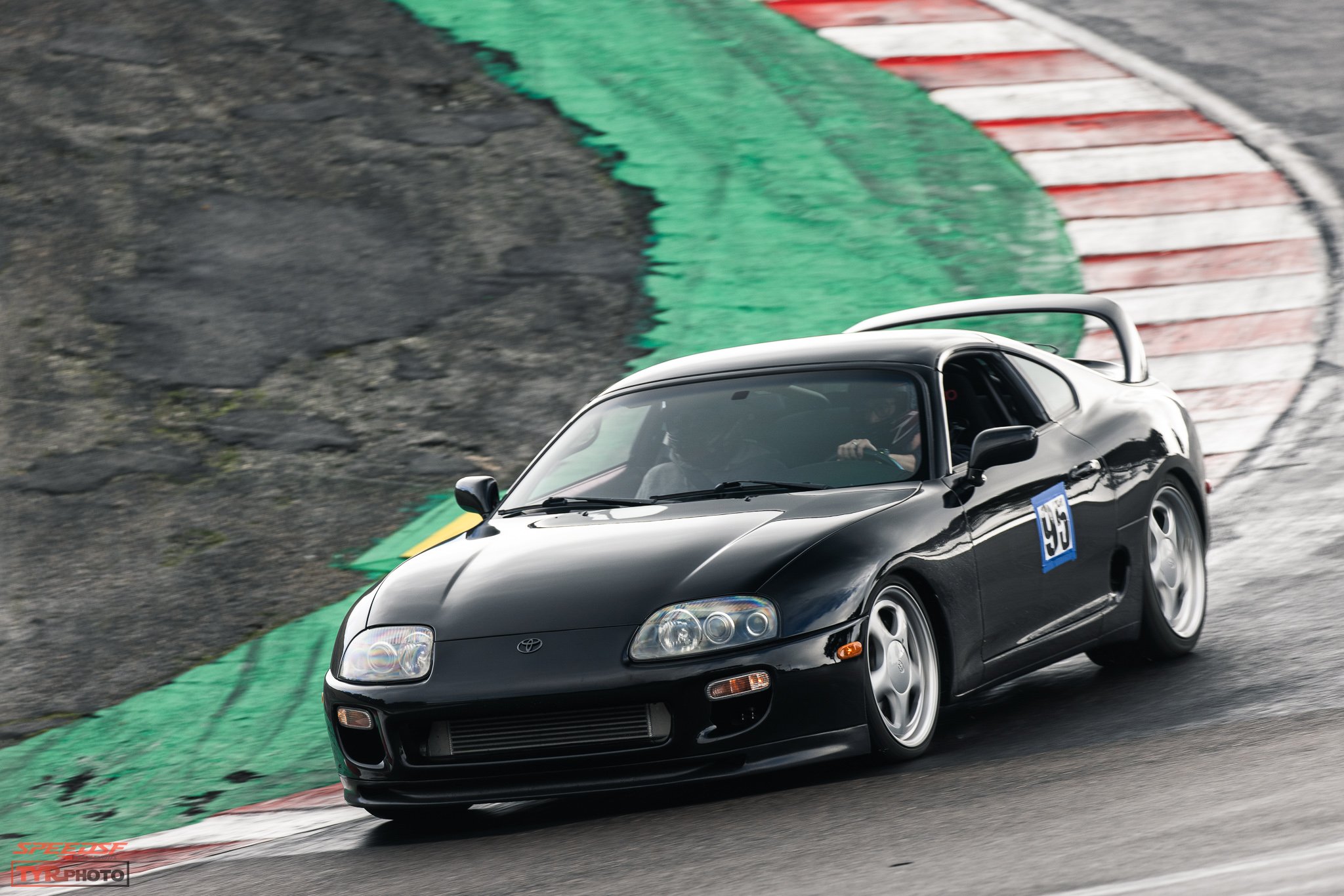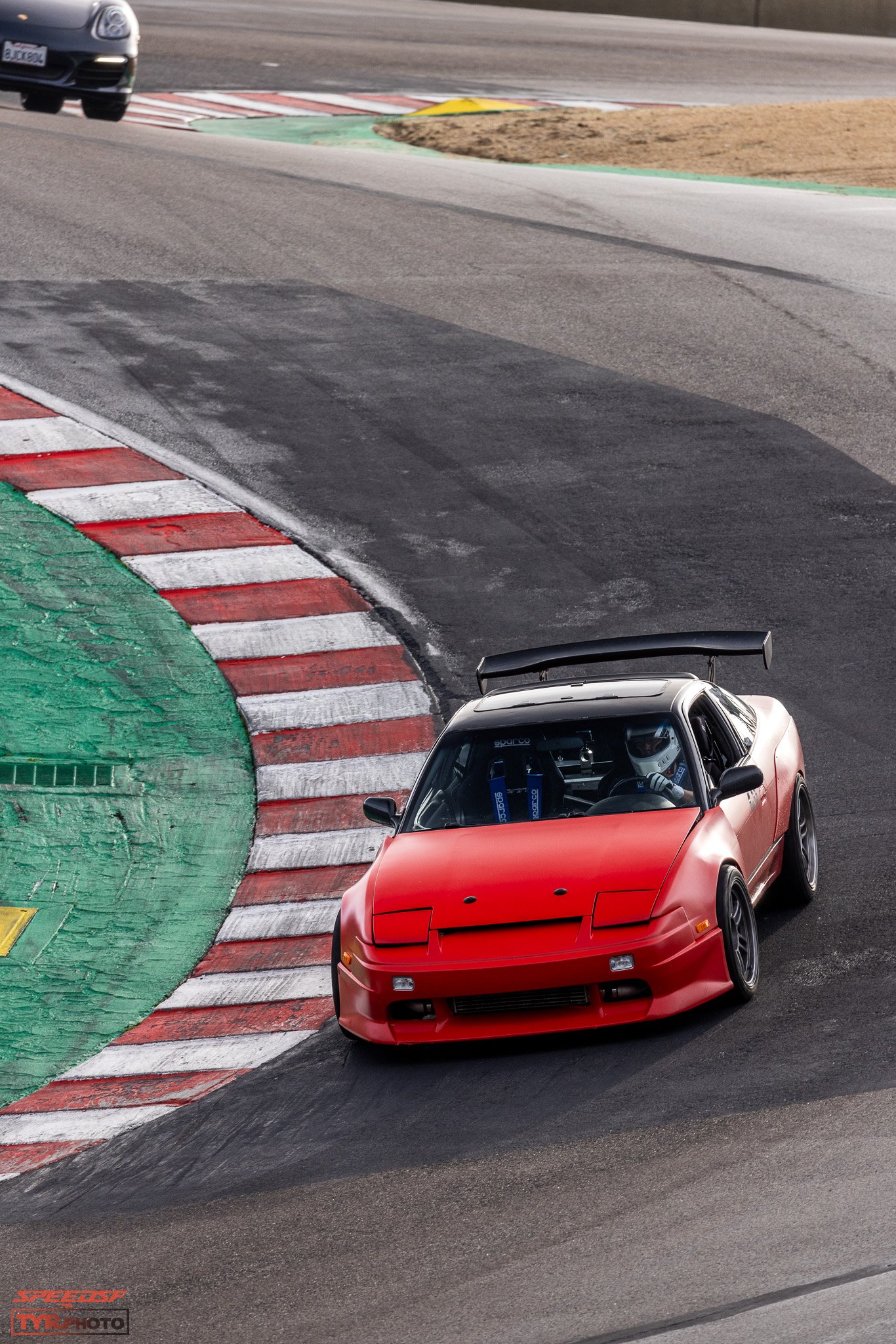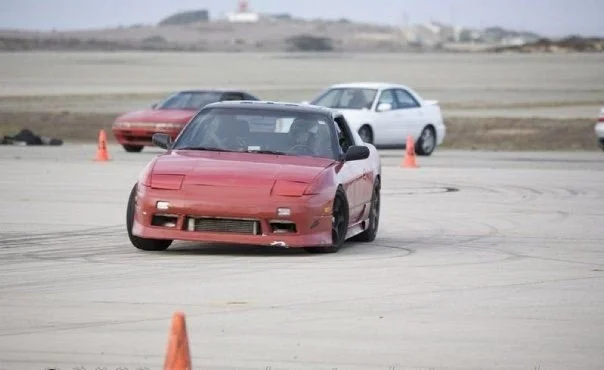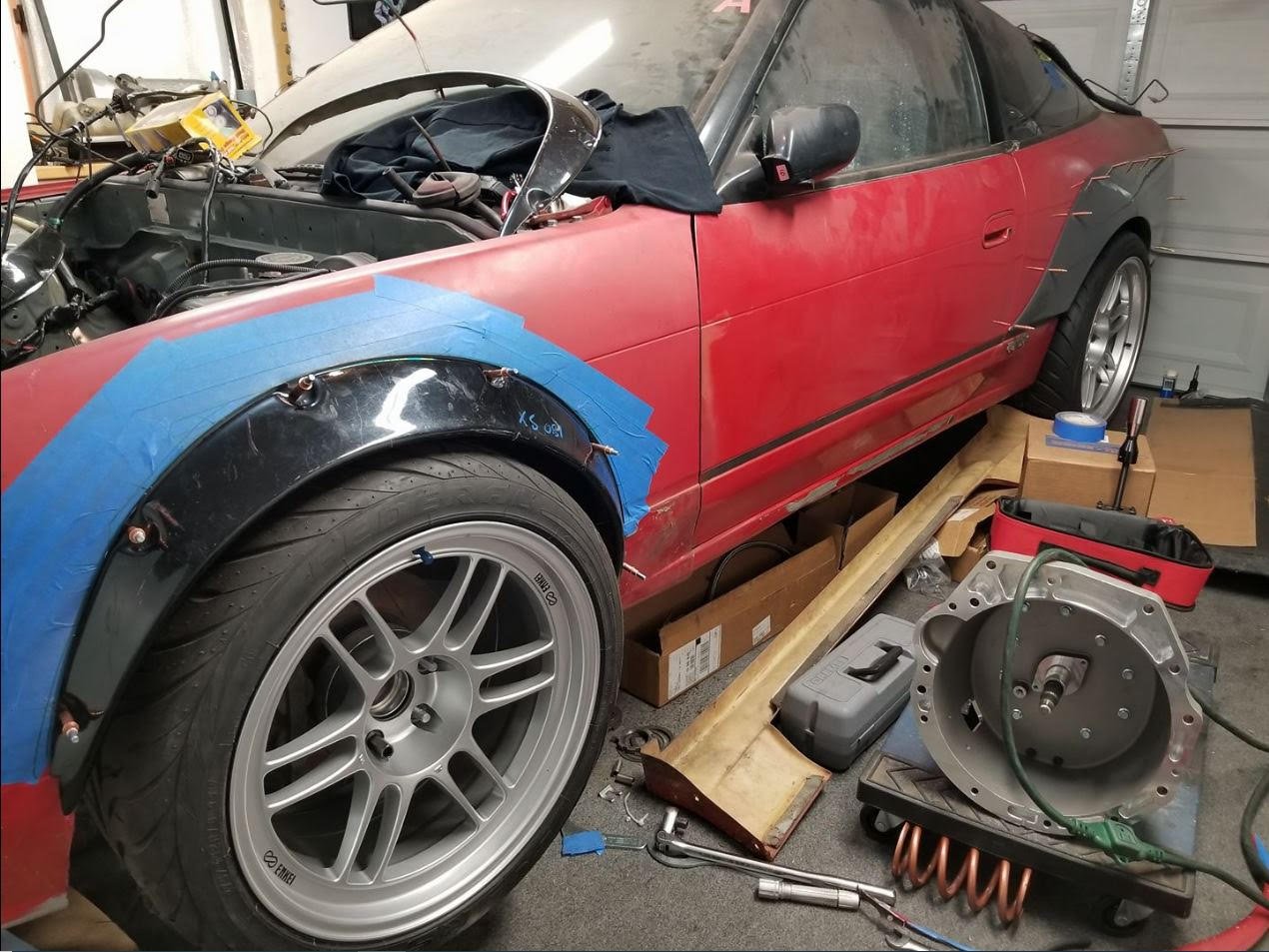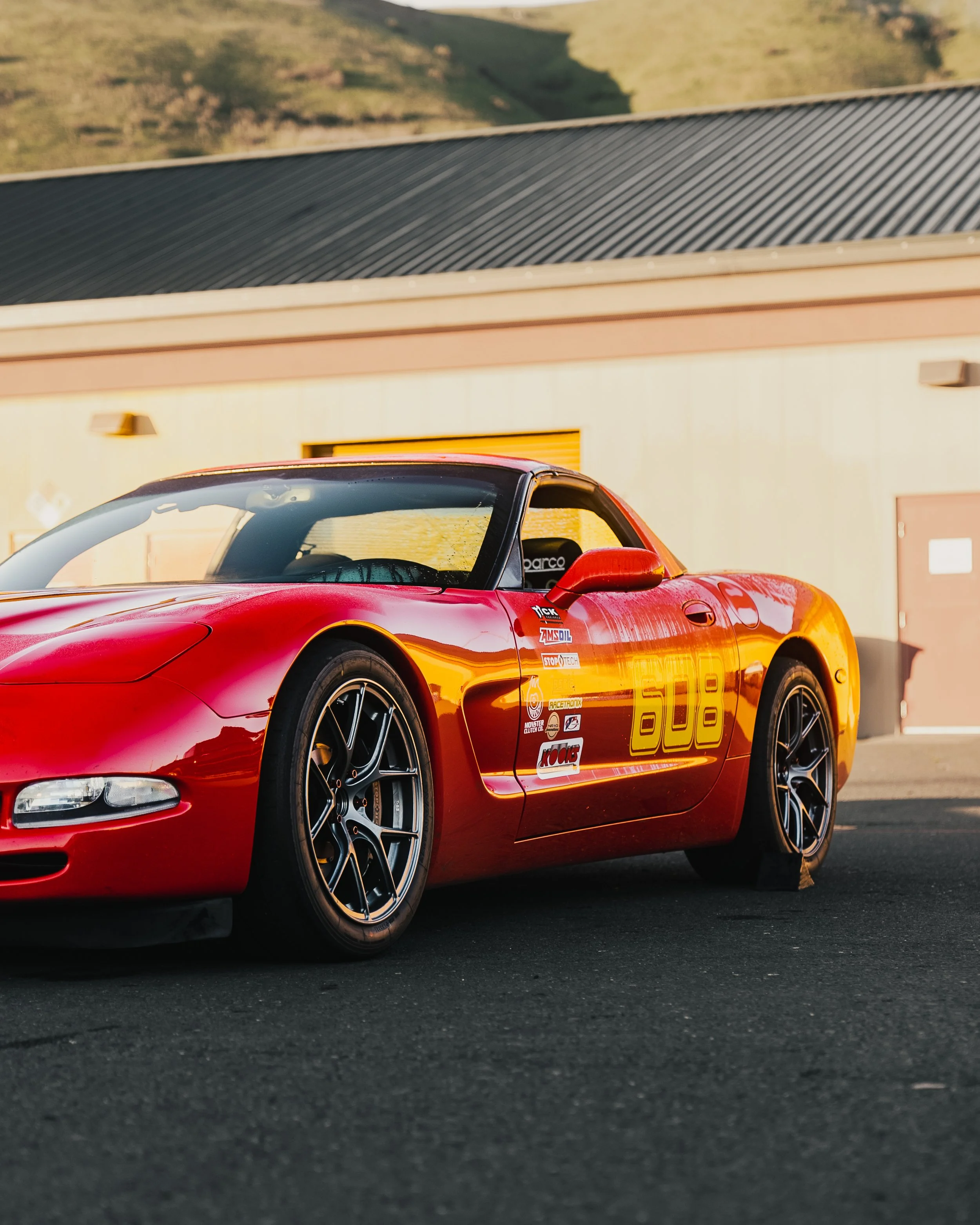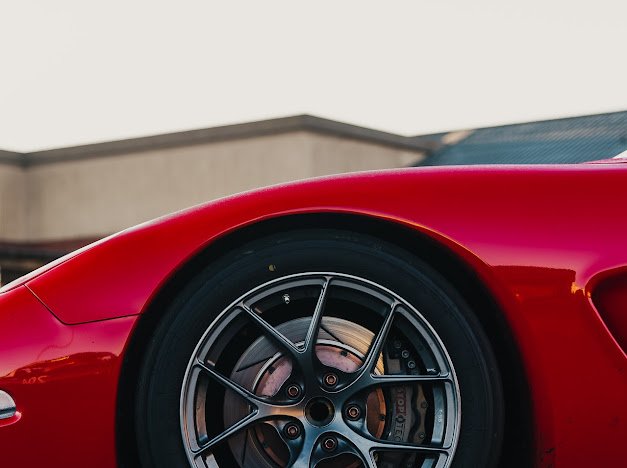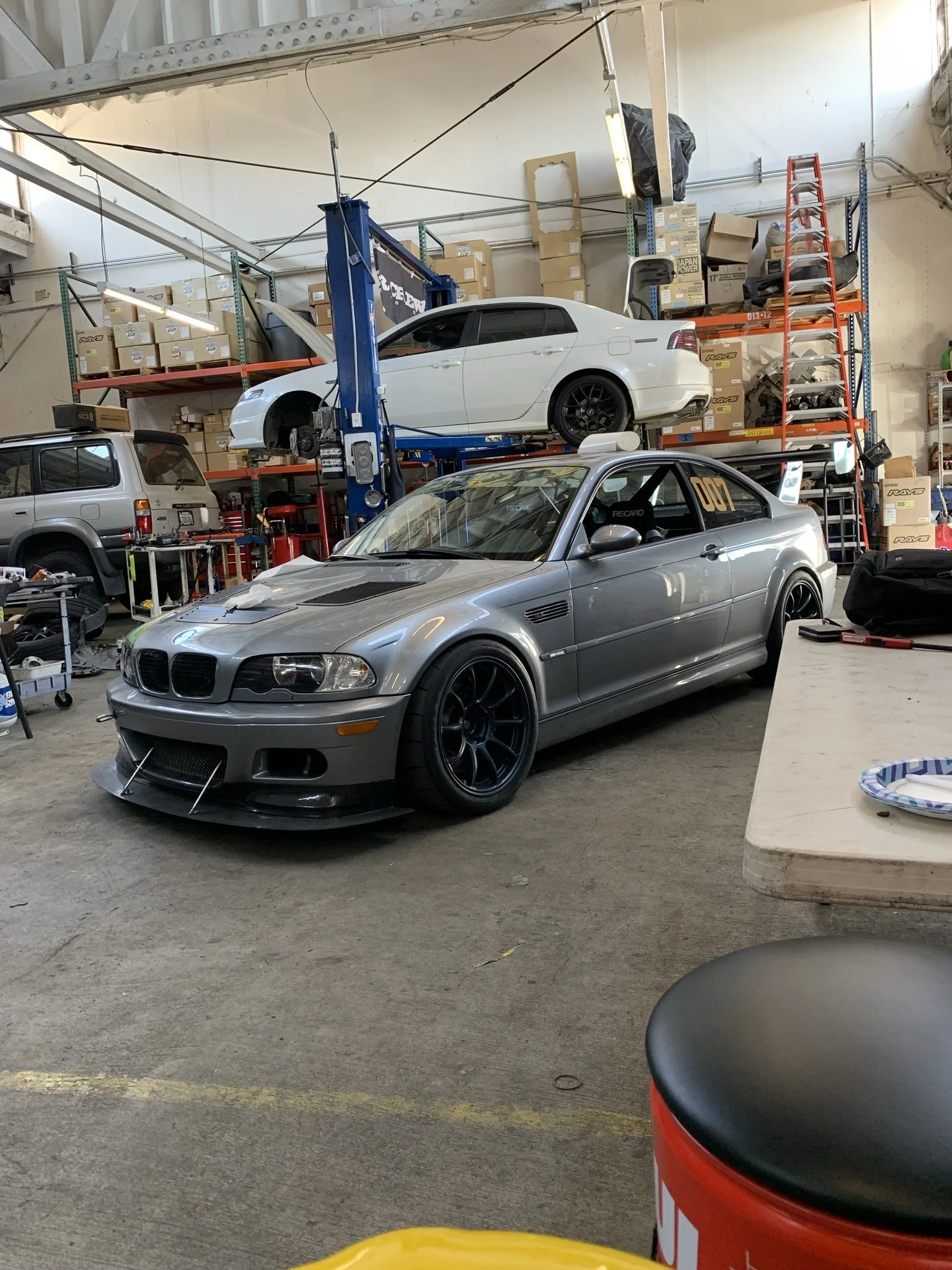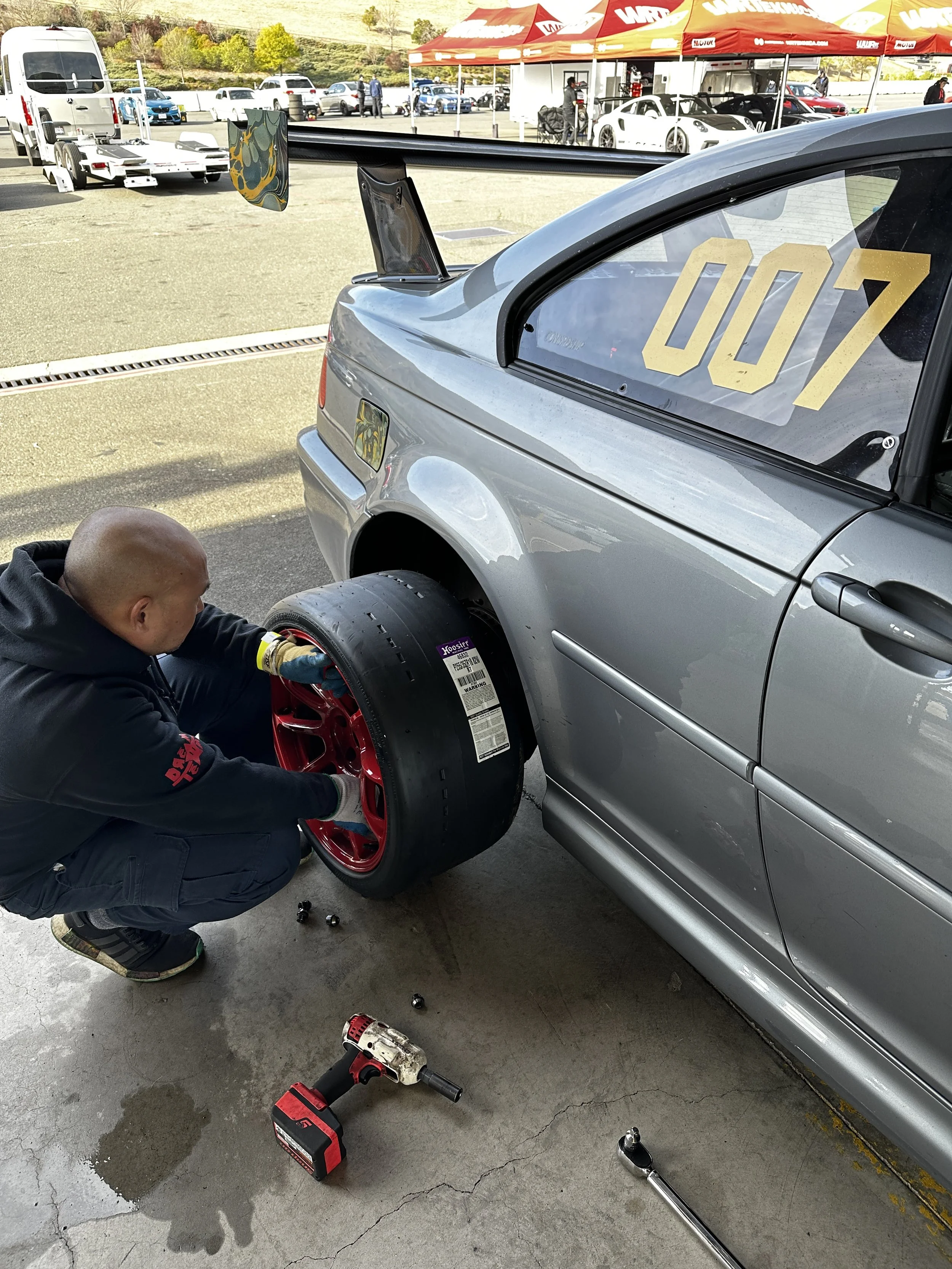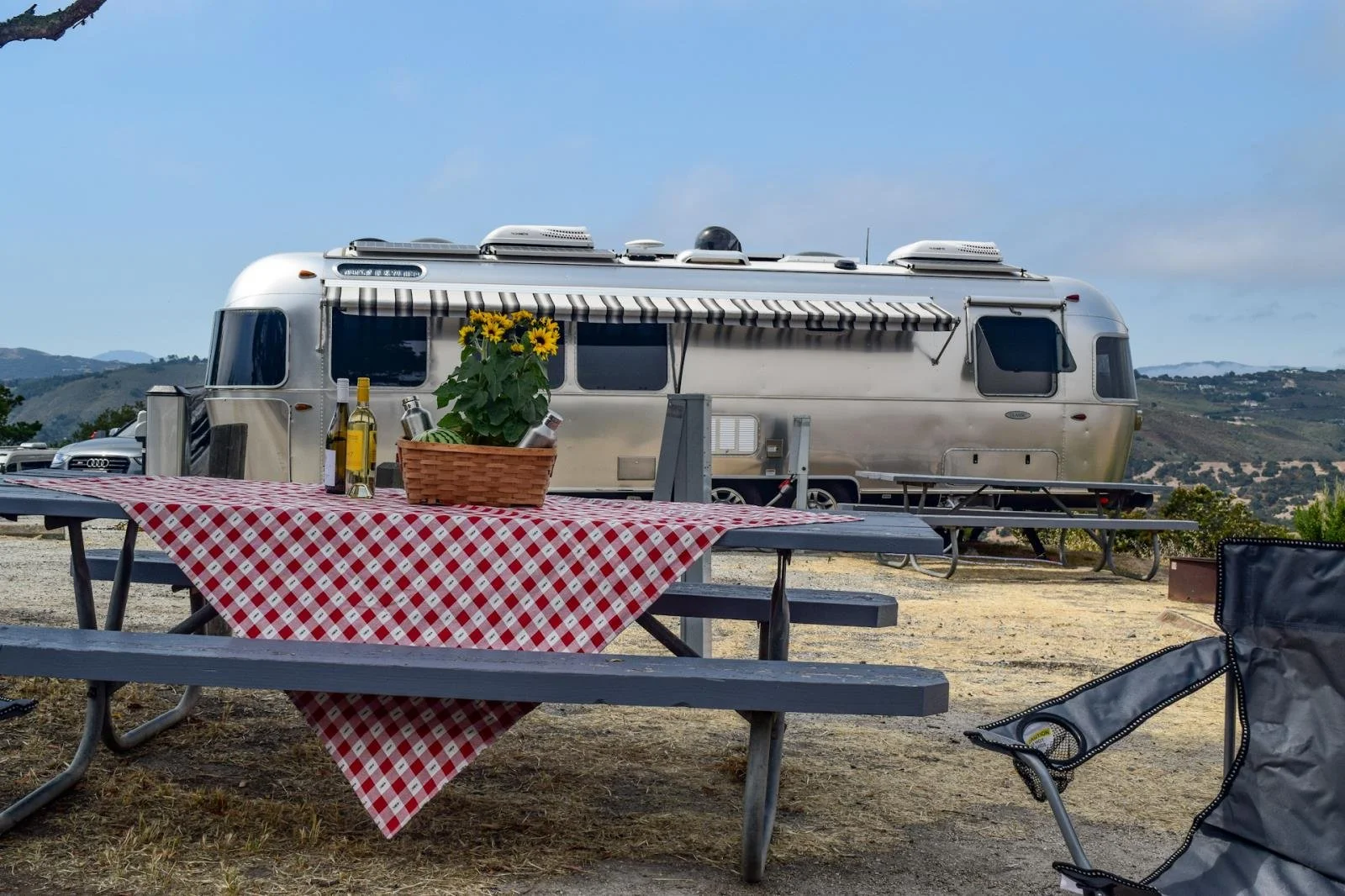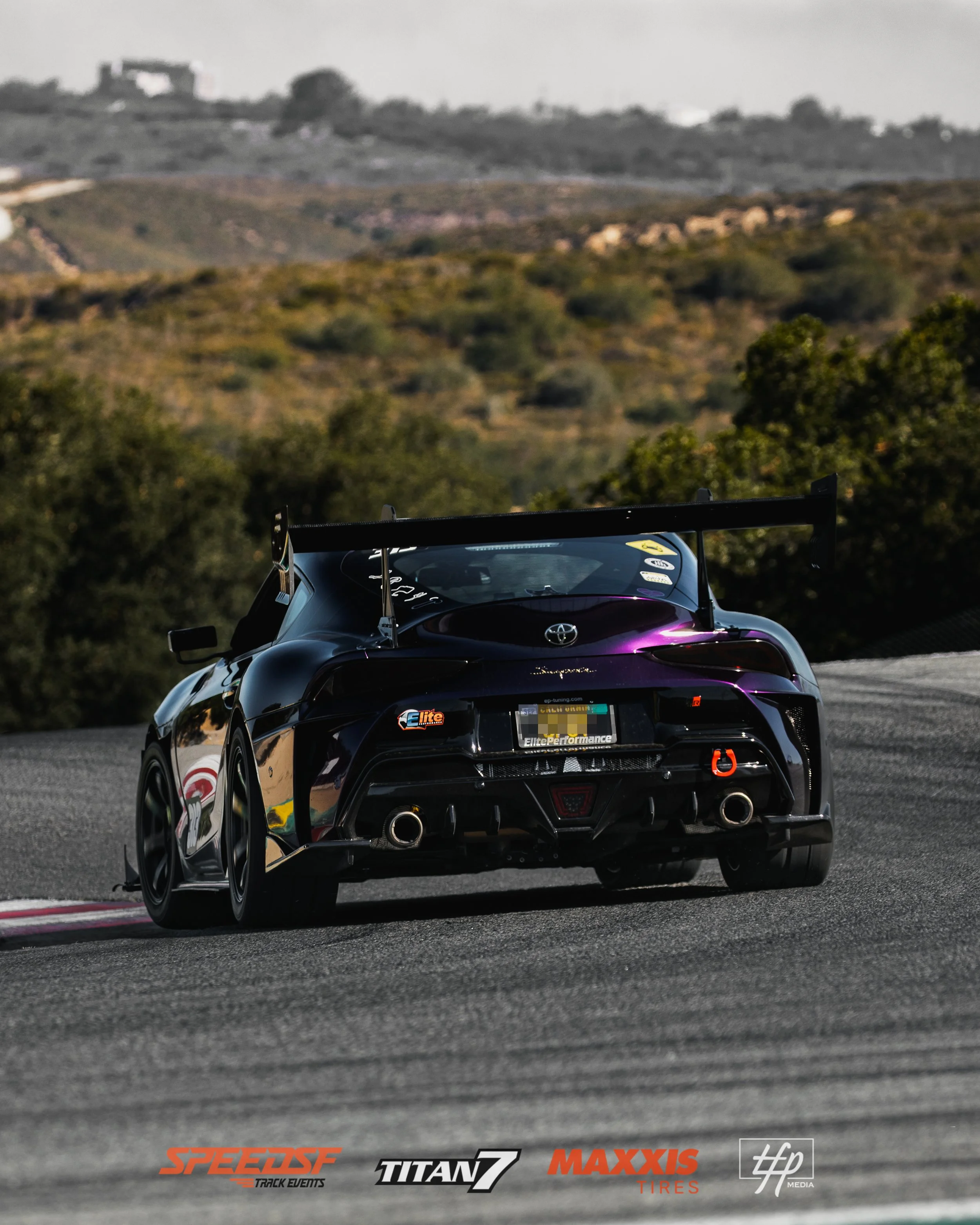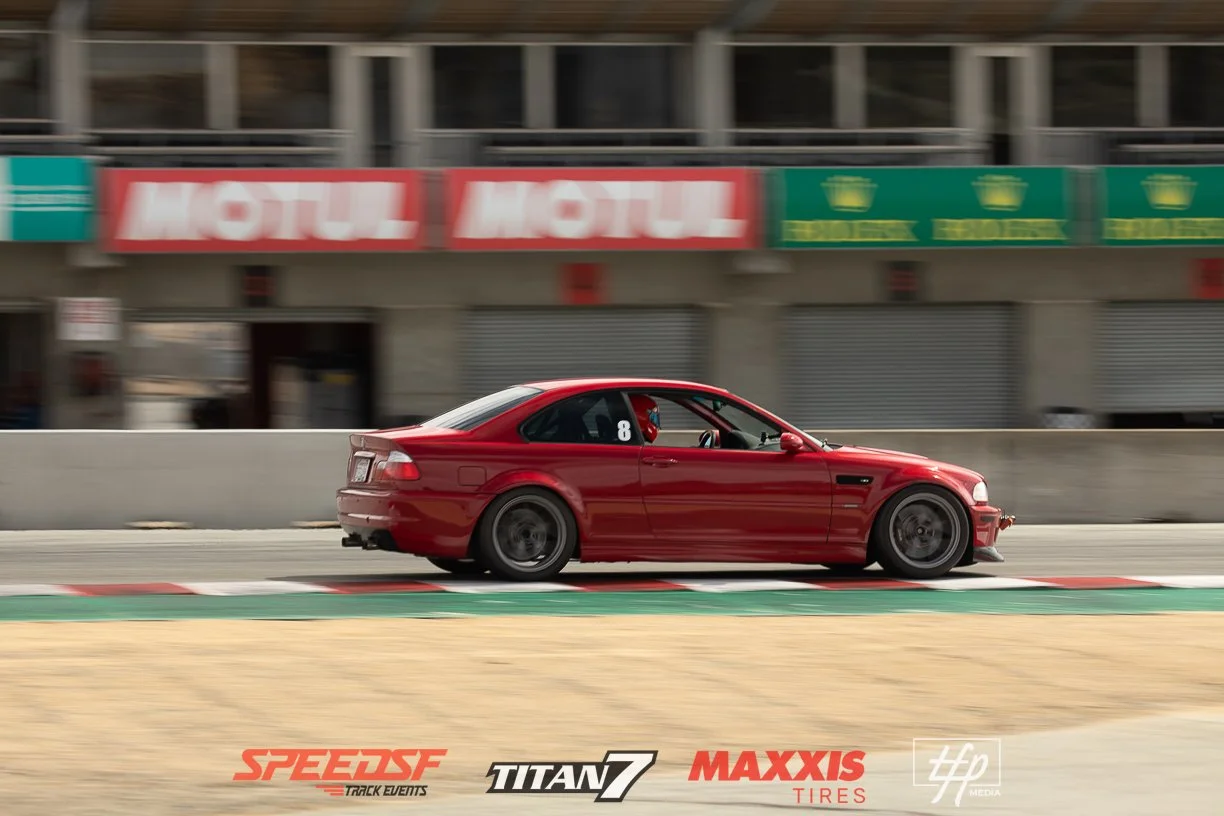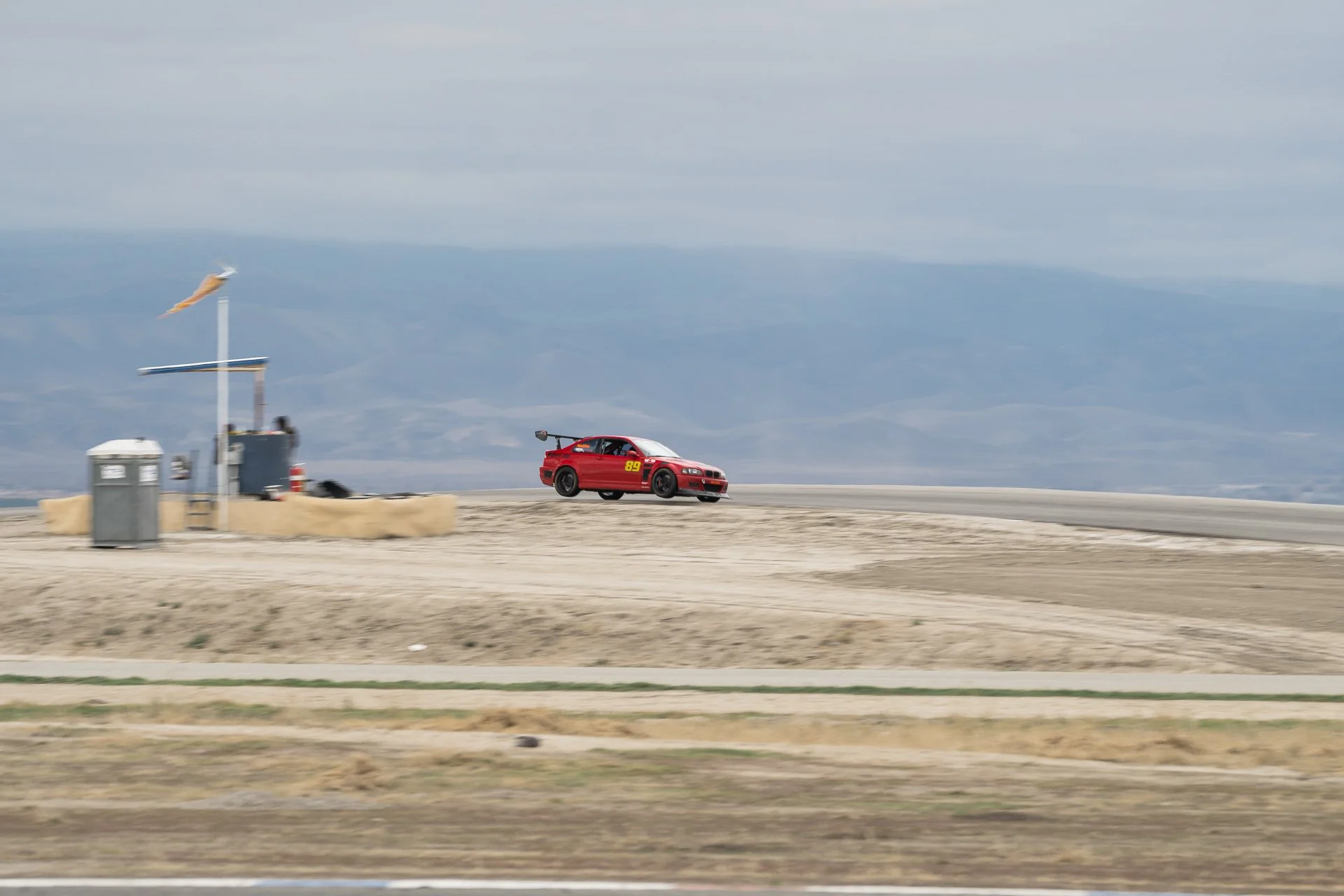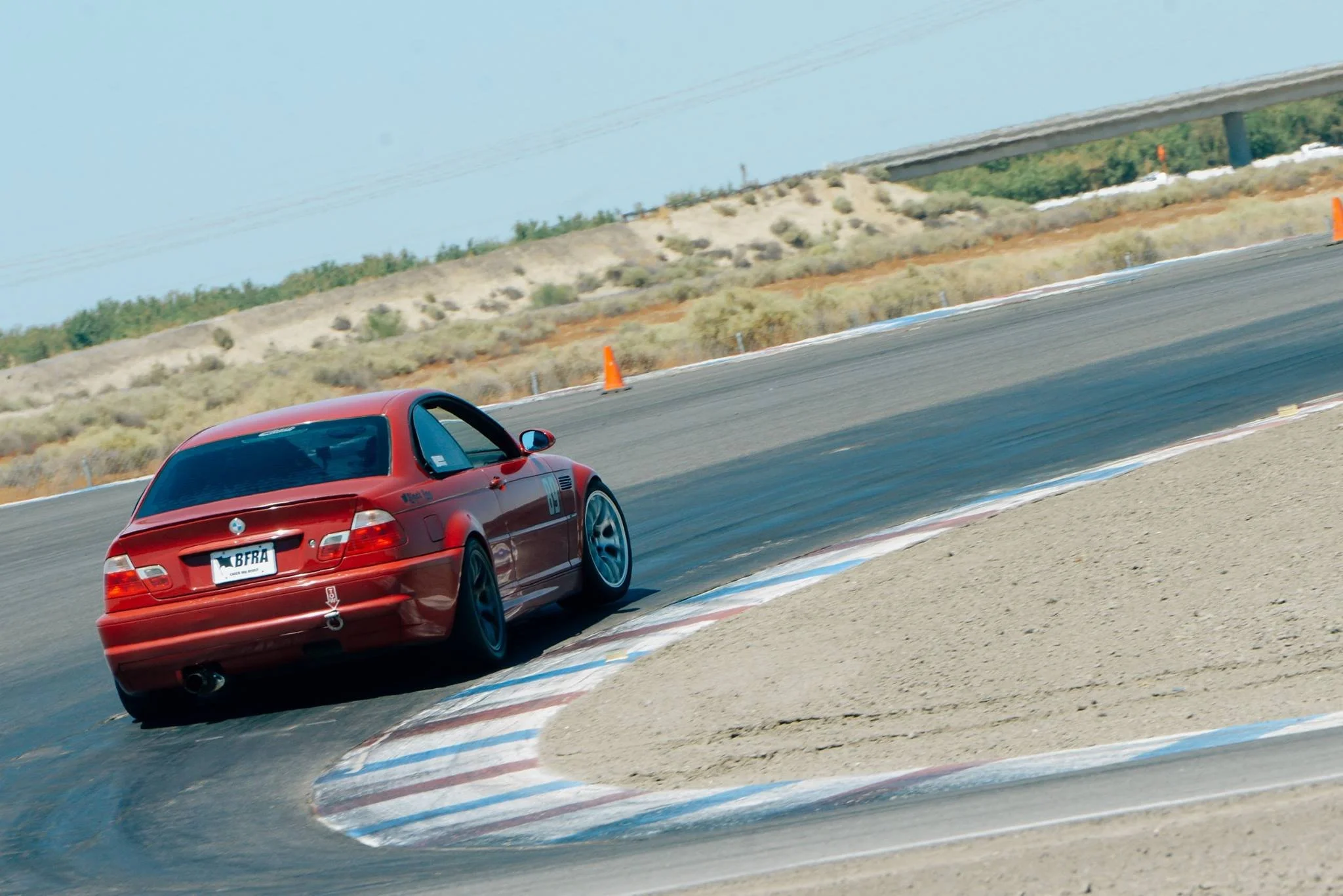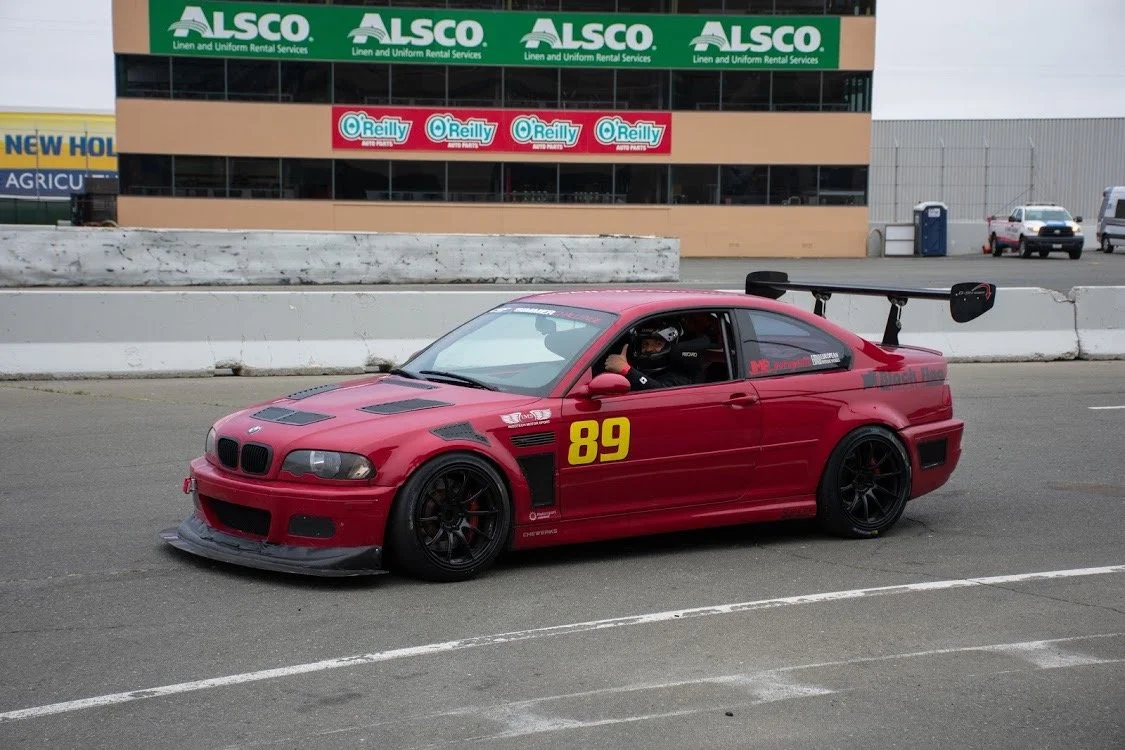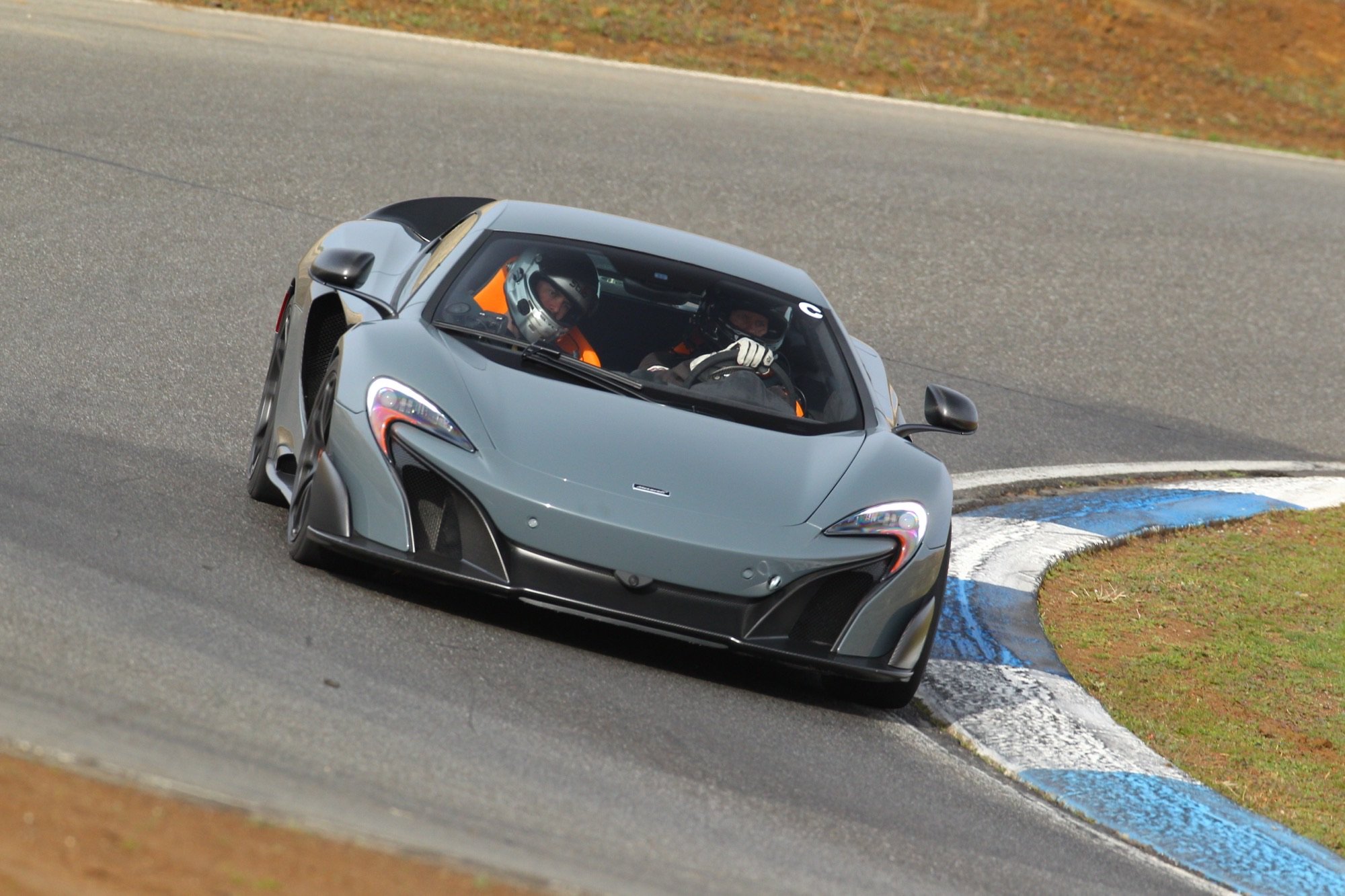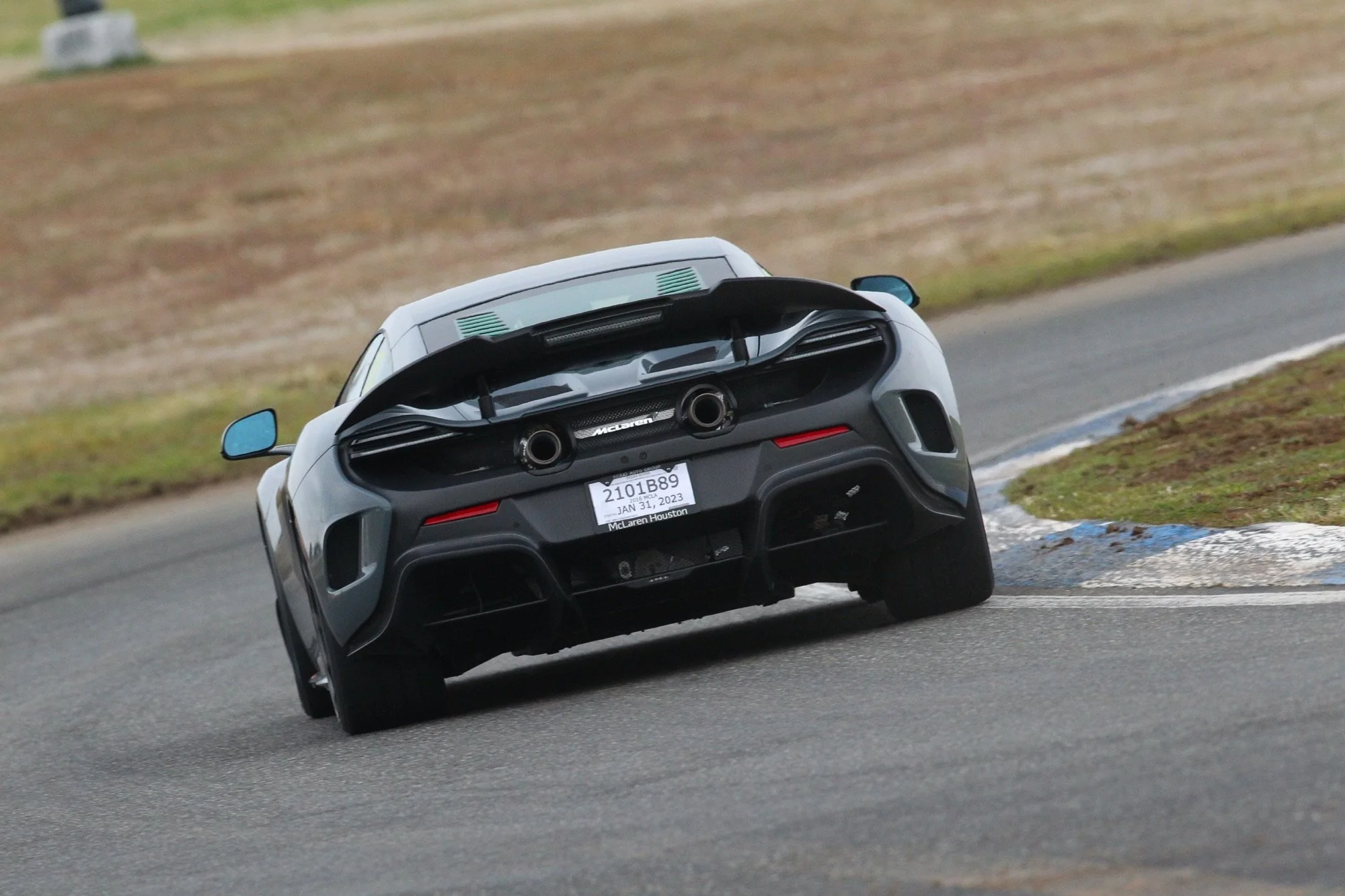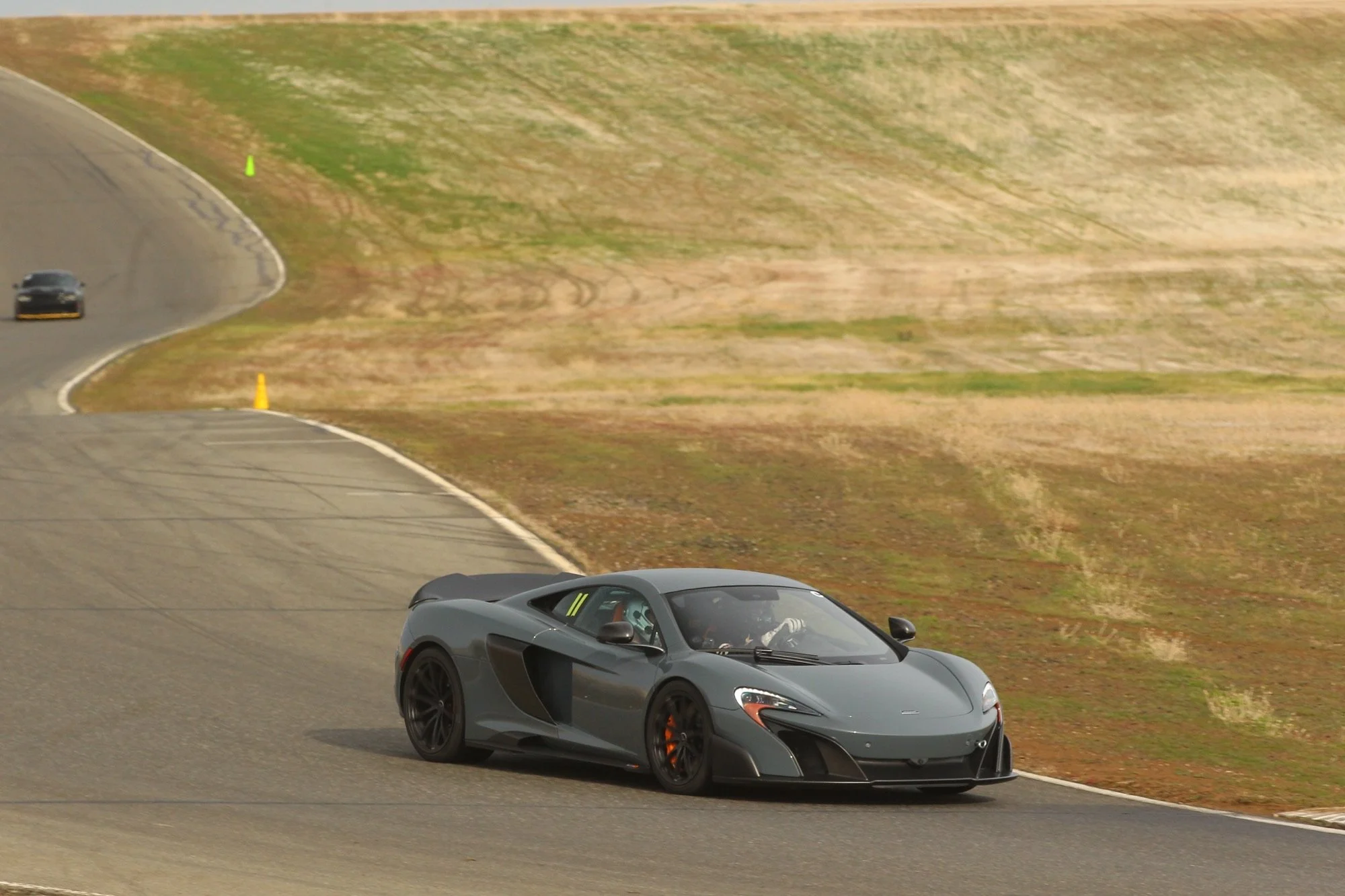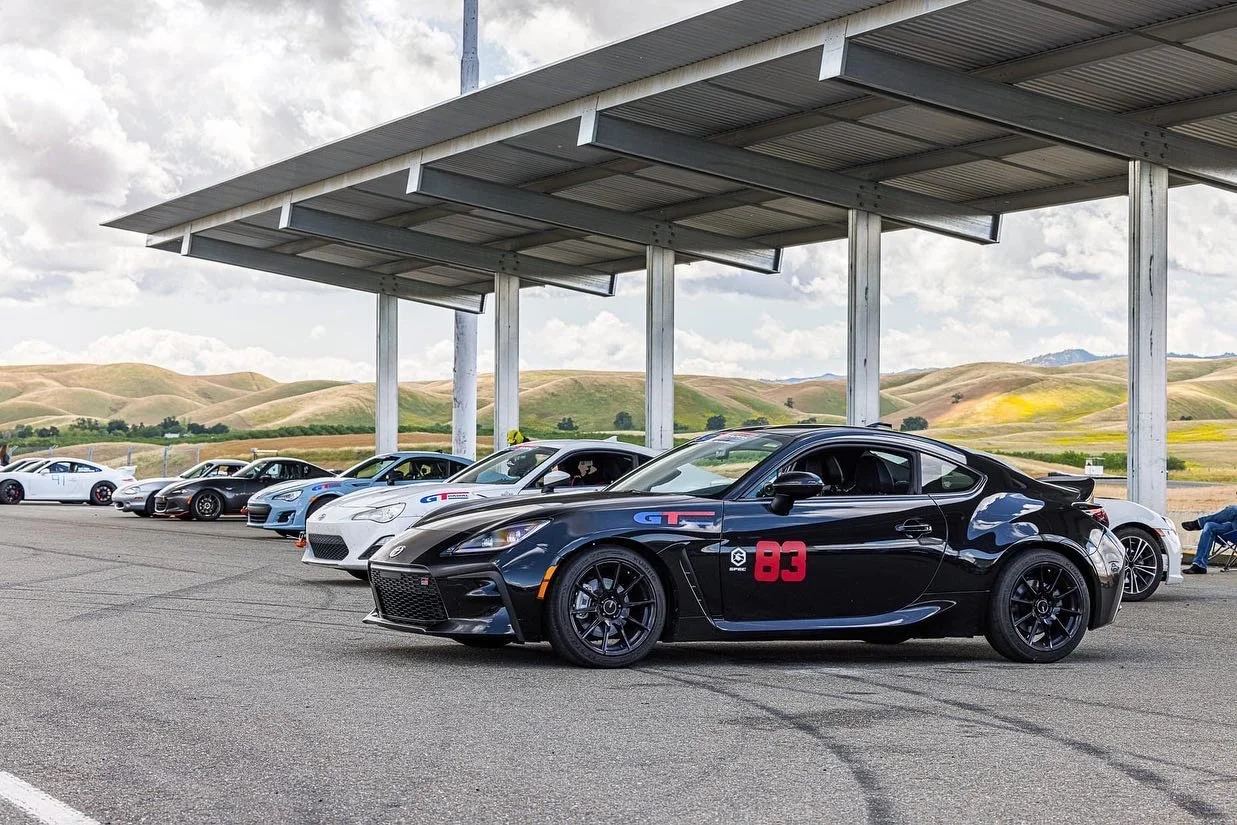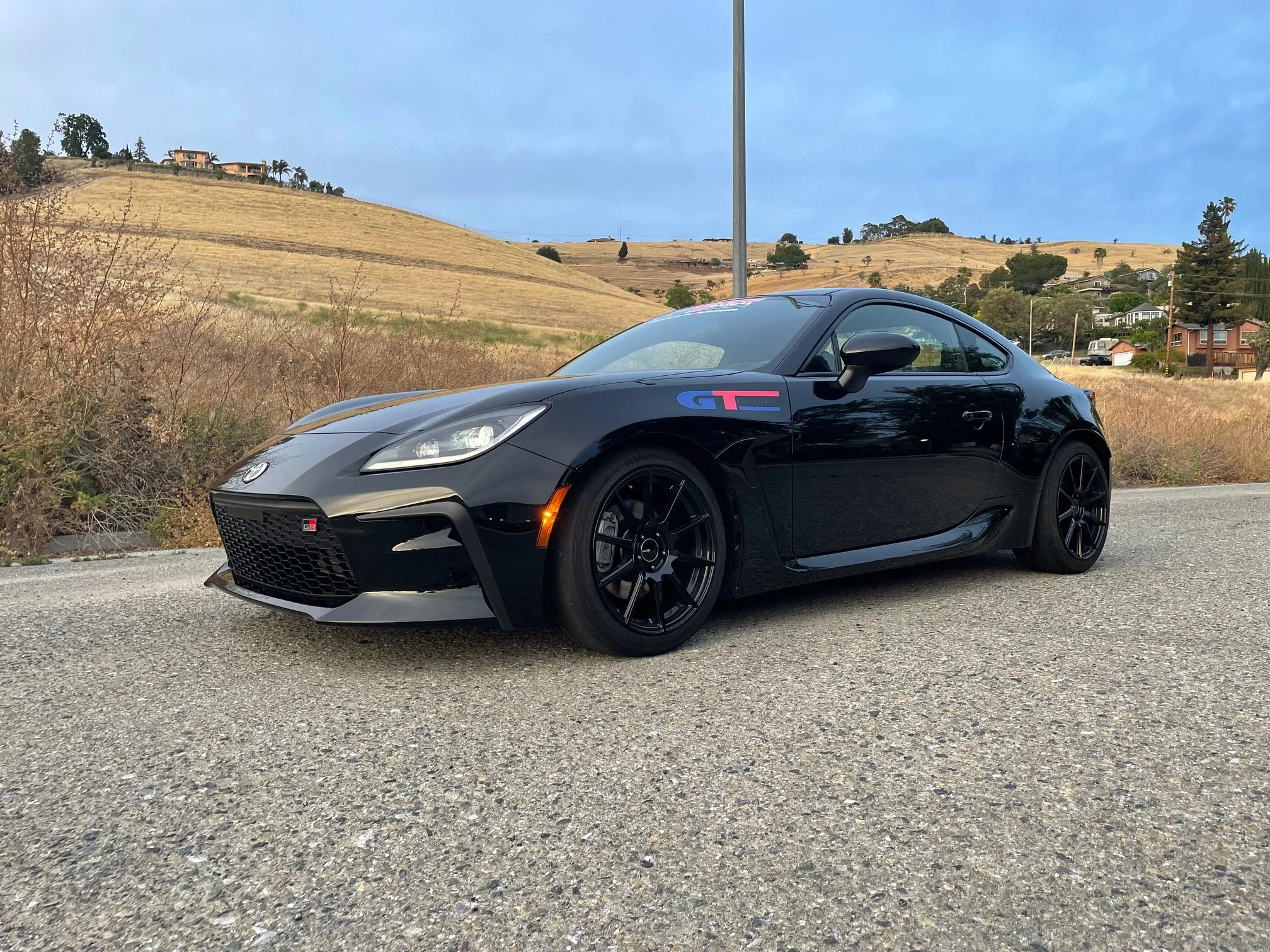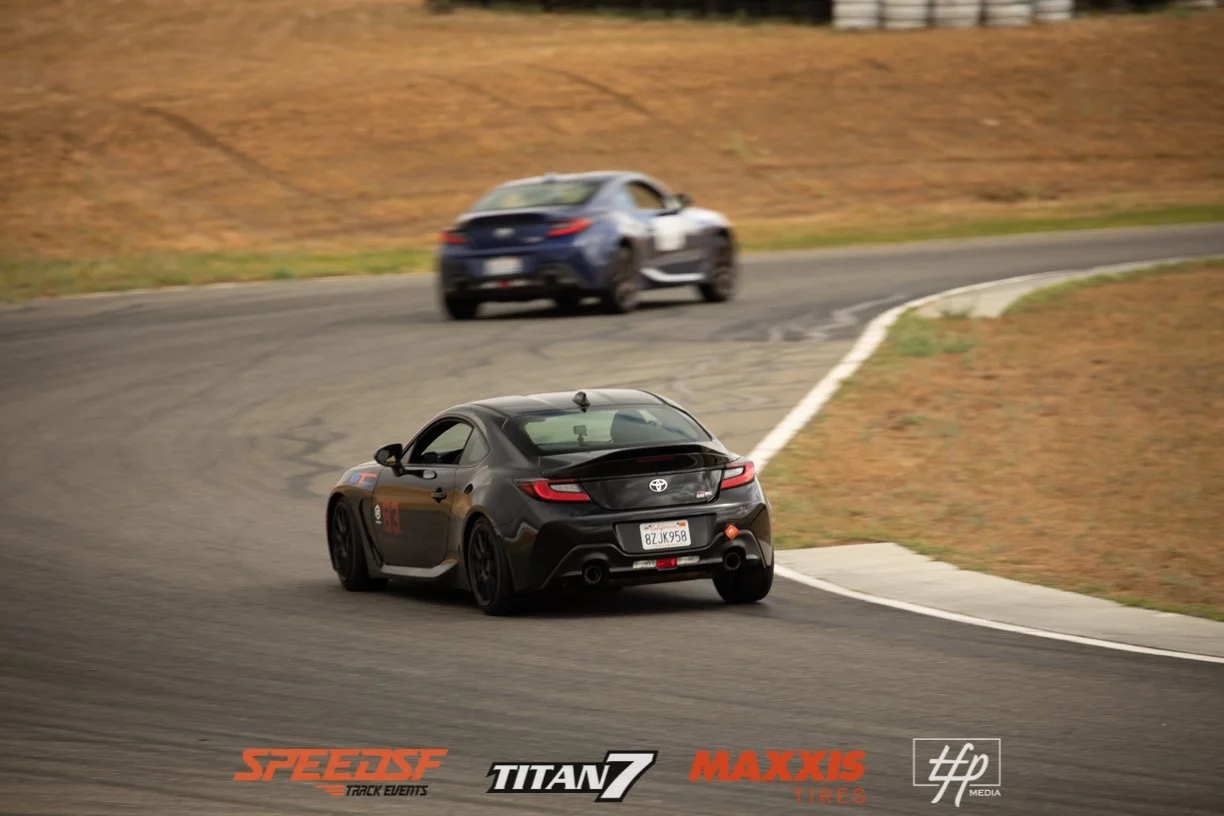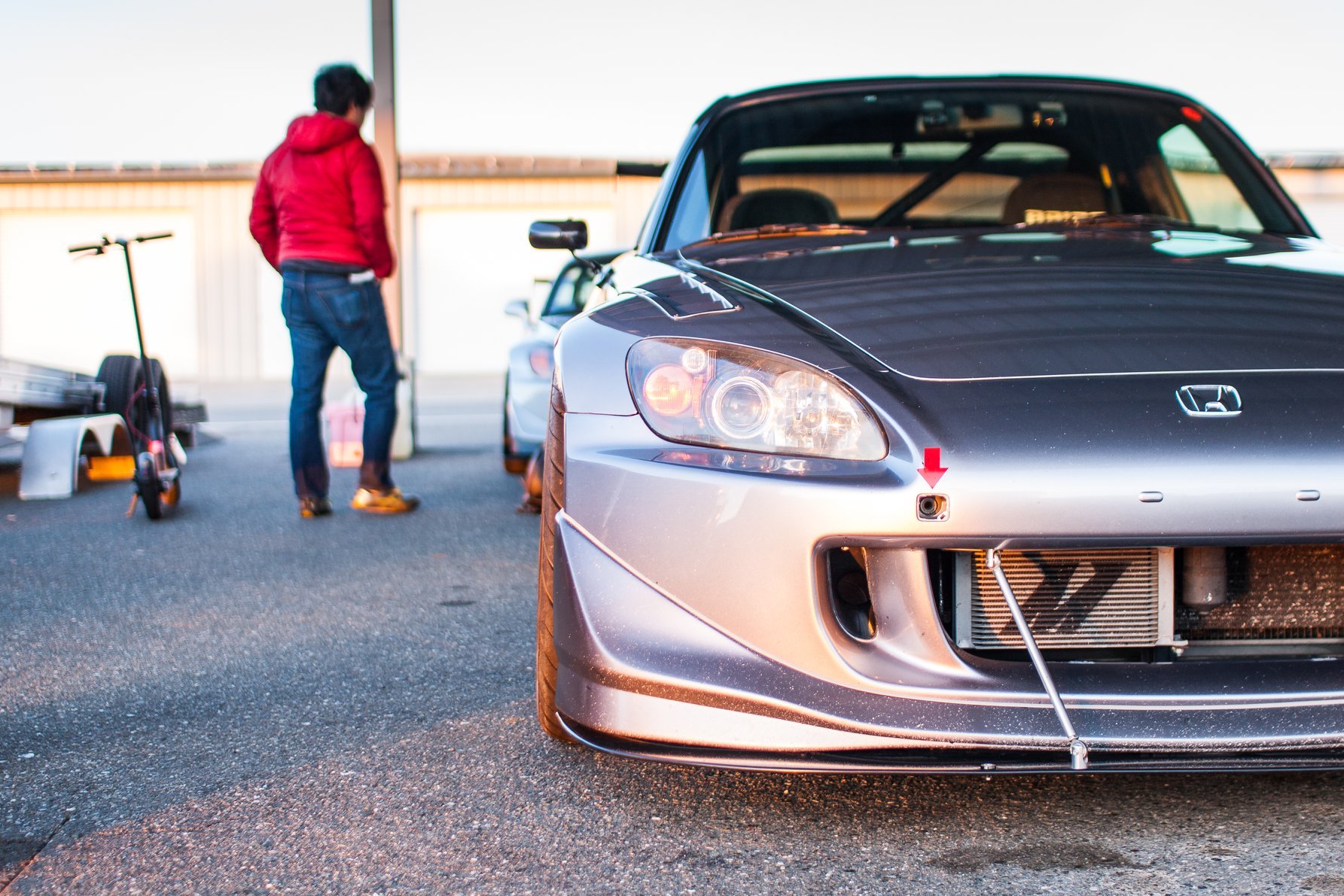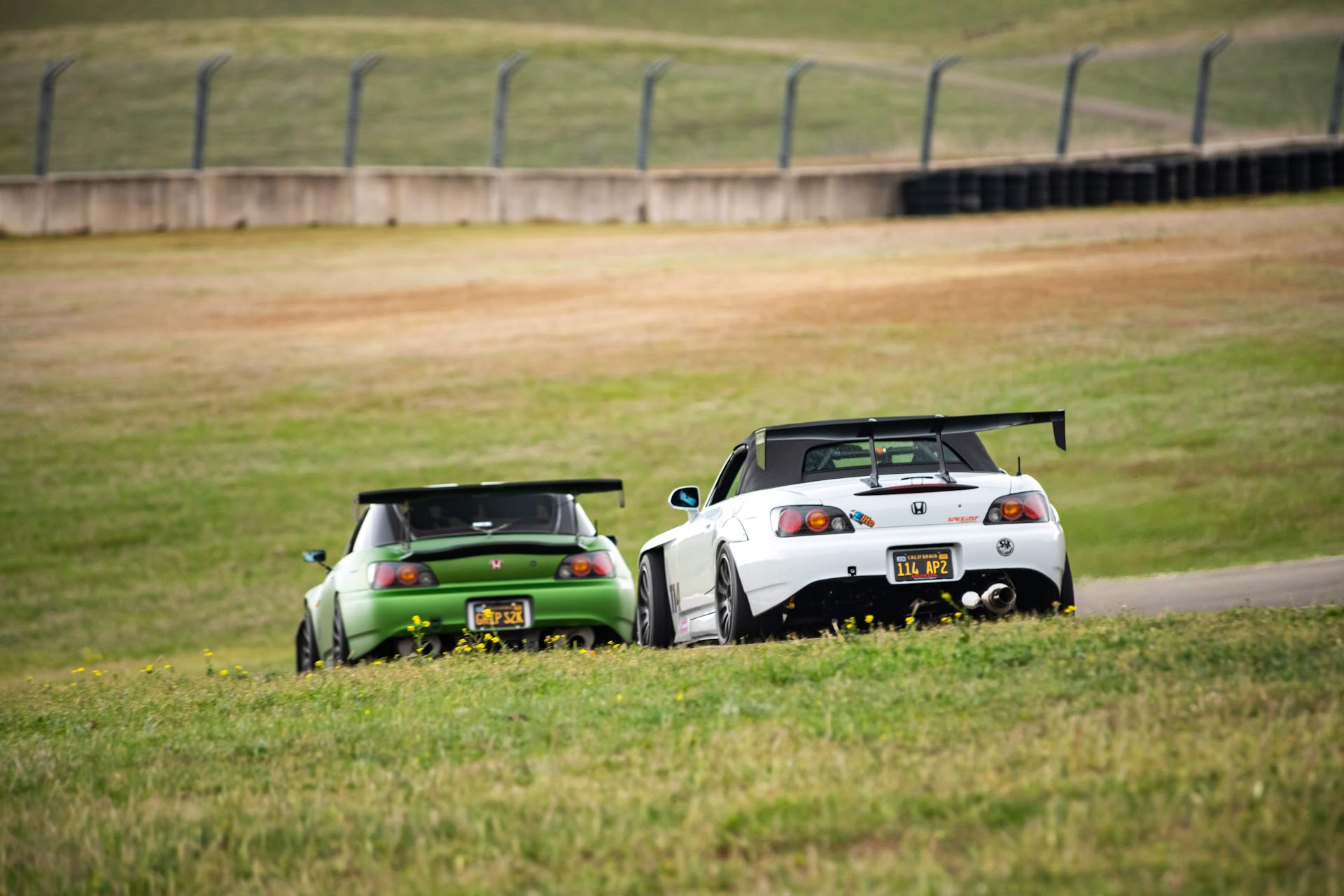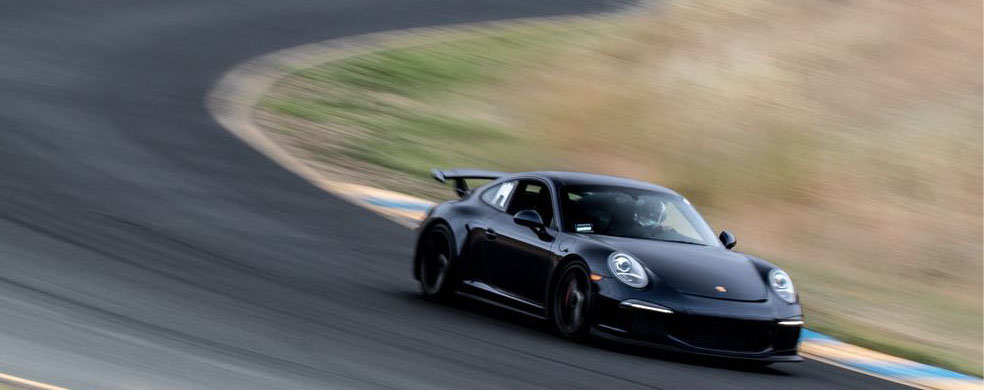
Sonoma’s Recent Repave Helps Set New Records
Sonoma’s recent repave — the first in over two decades — has helped Speed SF’s fastest set new records in three of the Challenge groups.
Speed SF’s drivers were fortunate to be the first members of the public to experience Sonoma’s new repave — the first in twenty-three years. One of Northern California’s most popular race tracks, Sonoma has been the site of NASCAR, IndyCar, and World Touring Car races over its fifty-five years.
Construction began after Christmas, with ABSL Construction of California milling out over 10,000 tons of asphalt from the track and pit lane, then grinding down the track, repairing old cracks, and laying the new asphalt.
Crack sealing in January.
Construction completed on February 23rd, two weeks before Speed SF was able to experience the new surface for ourselves.
The scenery was verdant, but the repave was far from green at Speed SF’s first full-track event of the season — enabling some of our front-runners to set new records in three of our Speed SF Challenge groups. Even those who hadn’t set new records set personal records. “The track is about three seconds faster than before,” Patrick Chio reported.
S4
In S4, Sean Win-Yepez cut 1.1 seconds off his previous best.
“There is more grip everywhere, but the gains are especially noticeable in T3/3A. There, there was so much grip that my power steering started to cut out!
One observation is that the curbs are not redone, so they now offer relatively less grip than the track itself, whereas before they were essentially about the same as the pavement. So, drivers who didn't use the curbs before will pick up more time than drivers who used them a lot.
My setup has remained pretty similar to last year, and I don’t think I benefited as much in the traction zones as some of the more powerful cars,” he added.
S3
In S3, power helped spread the distance from the previous bests a bit further. Spencer Kimball chopped the previous S3 record, set by him last May, by 2.59 seconds. In the last fifteen months, nothing about his setup has changed aside from some weight reduction. "The new paving really helps with consistency and driver confidence. Thanks to the smoother surface and lack of cracks, you can now take T1 and T2 on proper line instead of diverting your path to avoid surface undulations. I have yet to analyze my data and compare it to my previous run’s, but my lap times were about two seconds faster than my last event at Sonoma in 2023.
Based on my quick and dirty analysis, time was gained in T1, the exit of T6, and the T8/8A esses. One of the coolest features of this totally fresh paving is that my tires looked brand new after the event. Once it's rubbered in, I think we'll be seeing a lot more sub-40 cars at Sonoma,” Spencer predicted.
S2
In S2, Maxwell Lisovsky was able just to show what his monster E36 is capable of. It has benefited from the most development as of late, but that doesn’t take anything away from his staggering 1:39.3 — a whopping 3.5 seconds faster than his previous best. Now, applying the power cleanly in second-gear corners is almost an afterthought for a sorted track tool wearing slicks.
It seems that, due to gaining something more in the traction zones, the punchier cars have been able to take better advantage of the new grip available. However, even those in the budget cars and the underpowered scalpels will find something to love about the fantastic new surface at Sonoma Raceway. These times bode well for the future, which promises novel challenges for drivers and opportunities to push harder than they ever have before..
To sign up for Sonoma event on June 21st, click here.
.
Hubert's MKIV Supra: Soft Spot
After failing to find an E30 M3 to begin tracking, Hubert decided he’d get his HPDE start in a fourth-generation Supra Turbo: the slinky grand tourer he fell in love with during his teenage street racing days.
Like Ken Yu, Hubert Chan first got a taste of speed on two wheels. His motorcycling antics with his cousin Wil sowed the seed, but it wasn’t until one of Wil’s dearest friends gave Hubert a taste of acceleration that made even a 600cc bike feel a little lackluster. The stoplight-to-stoplight sprints in Phil’s modified fourth-generation Supra Turbo had Hubert hooked. “It just never stopped pulling,” he said.
However, Hubert wasn’t pushed in the direction of drag racing — he had an affinity for corner carving. An E30 M3 seemed to him the coolest cornering machine in his price range, but he struggled to find the right one. Eventually, he decided another platform might be more accessible, so he gave the big Supra a chance. This was 2013, back when both these iconic cars cost half of what they do today.
The Supra had left an indelible mark on him, and though not many had taken them to the track, his knowledgeable friends signed off on the Supra as a worthwhile sports car. When Hubert found the online listing for a clean, reasonably priced, and unmodified 1994 Turbo, he bought a one-way ticket to Salt Lake City and drove it back to the Bay, dreaming of future modifications the entire way.
The Supra Turbo had proven itself as a stellar road tripper; comfortable, quiet, and still torquey enough to pass anybody quite easily. However, it was a little on the boaty side, and Hubert sought out a few ways to improve the footwork.
First came a set of Fortune Auto 500 coilovers, and the resulting agility proved that the car was more versatile than its reputation had led him to believe. The Supra’s long wheelbase didn’t feel like an encumbrance on tighter backroads, and the way it sat securely over bumps and cambers made it quite confidence-inspiring.
The foundation was there for more power, which Hubert always knew would be the most exhilarating part of tuning this new toy of his. The promise of easy horsepower encouraged him to amass a large collection of engine parts over the course of the first year. By the time he’d had it for twelve months, he was ready to move onto the second chapter and double the power output.
With the help of mechanically-inclined friend, they pulled the factory turbochargers and replaced them with a log-style cast manifold and a Precision 6266 turbocharger, then fitted Kelford 264° cams and a full 3” Tanabe Medallion Exhaust. With some meth injection and a safe tune of the AEM V2 from Lawrence Shipman, the motor made a healthy 580 horsepower on 91 octane.
With the way the Powerhouse Racing turbo kit emphasized low-end torque, it became challenging to turn that into propulsion. To address the wheelspin issues, he followed the forum recommendation to replace the factory torsen with a TRD 1.5-way differential and increase the rear tire size to 295s, which he was able to do via widening the factory rear wheels.
For the final touches to the footwork, Hubert had consulted the Supra community for an appropriate sports alignment, but upon taking it to Elite to have it aligned, Melody Cannizzaro suggested a few alterations to his provided specs. With additional toe-in at the rear, the Supra felt reassuring and stable; enough so that Hubert was comfy stepping on the throttle in second and third gear. No longer was he hindered by the big torque, which gives relatively little warning before it hits.
The Supra had established itself a capable cruiser and a competent canyon car, but Hubert was most interested in seeing what it was like in an environment where he could really stretch its legs. It wasn’t long after that his friend Janning encouraged he take the Supra to Laguna, where he met his friend Samson, another track driver who’s been instrumental in getting Hubert up to speed.
After a few spins and some big slides, Hubert began to get a sense of just how much of the power he could use in Turns 2 and 11. The power must be applied gently in the slower corners, but it will put the power down in third, assuming the car is mostly straight. “The car was definitely driving me that day, but I didn’t care. I was addicted!” he exclaimed.
Over the next few events, Hubert began addressing the handling problems only apparent after a few fast laps. It was still a little too floppy from factory; the annoying targa top would flex to the point of requiring readjustment after every session.
Hubert parked beside his friend and mentor Samson’s M3.
Titan Motorsports’ four-point rollbar, reduced the flex and the need to fiddle on the targa between outings. Still, it remained too soft to transition crisply, so Hubert installed a set of SuperPro polyurethane bushings at the critical points in the suspension, Titan anti-roll bars, and a TRD strut bar. It’s tauter than it’s ever been, but it’s still a little on the comfier side. As a car which sees more street duty than track action currently he’s content with the setup.
Its ability to cruise to and from the track in total comfort isn’t something he’s willing to forgo in the name of going faster quite yet. The power is more than adequate, the car is controllable, and the engine doesn’t show any signs of stress. Essentially, it’s barely breaking a sweat with such limited lapping.
“I’m happy with the Supra in its current state for now, but once I get a little more comfortable pushing it, I might improve the brakes and the suspension.
It’s just an easy car to live with, and I’m afraid of ruining that. Plus, it gets so much attention in the pits. Some people ask me why I risk driving such a rare car, but I think it’d be wrong to keep it in a garage. Most people think it’s only good for drag racing, but the Supra is a great performance car — it’s very much at home on the track.”
Ken's 240SX: Twenty Years in the Making
Twenty years after picking it up, Ken brought a revitalized version of his old track car back to Laguna. It’d sat for a decade as Ken raised a family, but late those nights after the kids went to bed, he studied whatever he could and amassed a collection of track parts. When he finally got a chance to give it another lease on life, he didn’t cut any corners.
A student of motorcycles, Ken Yu spent his formative years tracking two-wheeled vehicles at Thunderhill, Laguna, and Sonoma. Eventually, he grew tired of taking spills and started looking for a four-wheeled way to get his fix. Specifically, he wanted something easily modified and cost-effective. Back in 2001, 240SXs could be found for nearly nothing — especially ones with blown motors.
A Zilvia.net posting led him to this 1989 hatch, which had been sitting for some time and needed a little love. Well, a lot of love. Aside from the blown motor, there were some serious issues contributing to the low cost of the car. “Someone left a burger in the back. There were maggots everywhere!” Still, $1,500 was a steal.
He started with a basic set of suspension upgrades. Whiteline sway bars, Megan Racing track coilovers, SPL lower arms and tension rods.
Out came the interior and in went the vinegar solutions. Then came a stock SR20, Z32 brakes, Tokico shocks, 5Zigen wheels, and Federal tires for plenty of fun in those halcyon post-college years. And this first round of modifications didn’t break the bank; many youngsters could swing these back then — no pun intended. When a full S13 front clip only cost $2,500, it was not too hard to put a quick 240SX together.
Rather than take the typical drifting route, he decided to make his 240SX corner. At 2,600 pounds with ~200 to the tires, the 240SX could graze 100 at the end of Thunderhill East’s front straight. It was nimble enough to get around many autocross courses, too.
By transplanting the motor without replacing the coolant hoses, Ken blew a pinhole leak in a coolant line at Thunderhill in the middle of July. Three of the ringlands broke, sending shrapnel into the head. He managed to limp the car all the way home to Hayward with regular coolant top-ups, but the SR was toast. He rolled it into the back of his garage with hopes to quickly replace the motor, but he didn’t bet on the next chapter of life taking him down a very different path than he’d pictured.
Ken got married, had two kids, a dog, and bought a house, so the track toy no longer took precedence. However, he kept the dream alive over the next five years by amassing a small stockpile of go-fast parts and tools.
Starting seven years ago, from ten to midnight — after the kids had gone to sleep, Ken would sift through his parts pile and make small steps towards rebuilding the car. Megan Racing coilovers with Swift springs, a pair of Sparco seats, an extensive cooling package, and a bolt-in cage set the tone: it was going to become a full-on track car built on years of forum trawling.
With his new CD009 on the floor, Ken spent a couple nights fitting Jun Flares and GarageMak overfenders.
Lots of research was needed to find out all the desired suspension settings for the 240SX — no darling of the track day community. With relatively scant information available for track-oriented S-chassis, he had to consult some of the video library he’d amassed over the years. “I’ve been watching Video Option since Volume 12.”
As this would be a fat-tired track car with a need to put power down better than what a stock S13 ever could, he had to identify the flaws of the suspension setup.
Up front, he added a set of Geomaster knuckles to lower the roll center for improved camber and toe curves. Along with that, he threw on most of the S13 parts in the SPL catalog, Techno Toy Tuning’s lower front arms, and even an S14 rear subframe for slightly better geometry and a wider track. Thankfully, retrofitting the older car with this S14 part only required a set of conversion bushings.
It would have to stop well, too. There were the two-piston rear Brembos sourced from a 2004 Subaru STI and mated to two-piece Girodisc rotors with Carbotech XP12s. Installing them was a cinch, too — almost a bolt-on affair.
At the front, the Core4 Motorsports Wilwood six-piston with Carbotech XP16s fulfilled the same need for easy modification, while offering far more reassurance than any hodgepodge of other car’s parts. Any track rat loves knowing that the kit on their car has been used by Core4 on their Silvia build for AER endurance races.
“Collecting all those parts was what kept the dream alive.”
When the ball was officially running, he called on two respected old school shops to help him rebuild the one piece he didn’t replace himself. Lonnie Jenson Co increased the SR’s bore to 86.5 mm and assembled the bottom end with Eagle rods and CP pistons. Performance Options rebuilt the head, while Ken added HKS Step 3 camshafts and dual shim rocker guides to keep the head from vibrating itself to bits at higher revs.
With a whole new fuel system and a Link G4X standalone ECU to decide on the right blend, Ken knew that he’d be stretching the stock gearbox to its limit. A Mazworx conversion kit, a CD009, and an ORC twin-clutch disk made up the the beefy new drivetrain — more than strong enough to handle 360 horsepower at 310 lb-ft at 5,500 rpm. That was sent back to an S15 helical differential with a 4.3 final drive. The combination of this gearbox and rear end resulted in explosive acceleration.
After bolting in and tuning the new powertrain, the car would hook when pointed directly ahead, but the lack of compliance over surface variations caused Ken a few spins. At first, Ken struggled to find much grip coming through Turn 3 and 3A at Sonoma. “The inside wheels kept losing contact due to the lack of droop and suspension compliance. The solution was to ensure 30% of the suspension travel was reserved for droop through the helper springs,” Ken noted.
With more toe-in at the rear and a TCS Sportline rear wing, the car’s stability improved at higher speeds and under heavy braking. Being heavier in the front than the rear, it still gets a little light over the crest of Laguna’s Turn 1, but it’s less than vicious. The wingless iteration felt like it might bite his head off.
To expect much more from the projet would be unfair. December 30th was the first time he had this car on track in over a decade. And, wisely, Ken wanted to study the ways to get a dependable car out on track first.
Clearly, Ken’s done his homework. The engine manages temperatures well for a turbo car — admittedly, only cold-weather testing has been done so far, but it’s likely cooling won’t be a problem except perhaps on the warmest days.
The geometry is improved, the drivetrain handles the horsepower well, and the maintenance it requires is relatively low for an old Nissan. There’s also little tweaks that show an attention to detail and an emphasis on presentation, like how the ISR exhaust extends far enough to avoid blackening the bumper. It’s pretty — and that’s not always a great descriptor for a 240SX with bolt-on over fenders.
The attention to detail and insistence on putting reliability first will make the car’s issues easier to diagnose. However, half the car’s ancillaries are OEM SR20, so time will tell how well they’ve weathered the elements.
It’s clear Ken’s laid the right sort of foundation. Coilover testing, adding a front splitter, and increasing body rigidity are the main items on the agenda. Seam welding around the hatch and the doors — two massive apertures for such a small body — should make another massive step forward in making this middleweight handle well. Buttoning it up will take time, but Ken’s already sunk two decades into this car and his enthusiasm for tuning the 240SX hasn’t diminished one iota since the start. In the grand scheme of things, what’s another year?
Thomas' Corvette: In Good Company
In only two years, Thomas has learned more than most will grasp in a decade of track days. Having a solid, dependable C5 has helped him put in his time, and having Elite Performance as a resource has made fine-tuning the car so much simpler.
Finishing out his senior year of high school, Thomas DiGioacchino listened to a friend’s suggestion and scrounged the money together for his first track day. Crap tires, decent weather, and a near-stock Mustang GT were all he needed to find that thing that’s been steering his life for the last five years.
Thomas decided to pursue the mechanical side of things and enrolled in Ranken Technical College’s High Performance Technology course with a focus on Chevrolet LS engine design.
That emphasis allowed Thomas to build a motor for a car he hadn’t yet bought. It began with an iron-block LQ motor and LS1 heads, and as the LQ block only displaced 5.3 liters, he bored and honed it out to 5.7 liters to fit the LS1 head. With forged pistons and rods, oil pan baffles, and the other pieces that made it a 500-horsepower workhorse, he unknowingly set the tone for the rest of this build.
The car itself came next. During his final year at Ranken, he found himself a base 2002 Corvette within his price range and tucked it away in his side yard until graduation, when he loaded up his truck with his furniture, his motor, and began his drive from Missouri to his hometown.
Back in San Mateo, he reached out to his then-limited network for car parts and, with some luck, gainful employment as well. As he’d relied on Elite Performance to direct him towards a few bolt-ons for his Mustang, they were the natural resource to consult. One day, while speaking to Elite’s Melody Cannizzaro about getting his Corvette aligned, she provided up with a job opportunity. He didn’t have to think twice.
Working with Elite gave him access to one longtime customer who happened to be offloading some go-fast bits from their recent Corvette build. Thomas was able to grab a set of Titan 7 T-S5 wheels for peanuts, and then came big brakes, bushings, and a bucket seat. Soon, the plans for keeping the Corvette tame and civilized went out the window.
Wisely, he went for safety equipment next, and decided that this car would only help him become a truly quick driver if it was reliable first and fast second. “I knew that seat time would be the priority if I was going to run with guys like Gary Yeung,” he said.
That said, it would be silly not to make use of the big motor sitting in his parent’s backyard. Soon, it found a new home in the Corvette’s engine bay, and Thomas took the half-built C5 to its first track day, where it ran without a hiccup. It ran well the second day, too, as well as the third. Clearly, he’d paid attention in class.
Aside from the minor repairs any twenty-year-old car needs, it was the epitome of dependable. His focus was on learning to drive the car better, but, to his credit, a C5 on stock suspension does leave a lot to be desired. It would lean excessively, and under trail braking, it had a habit of snap-oversteering.
After several months of saving, Thomas bought a used set of JRZ two-ways. While he was at it, he pulled and refreshed the entire drivetrain, then upgraded the springs and clutch packs in the OE LSD. Those modifications made the Corvette much more progressive at the limit, regardless of whatever cheap tires he happened to be running.
When he found the time to fine-tune the suspension, he increased the rake to increase rotation at corner entry. A square 295-35/18 setup was the cost-conscious tire option, and he stretched every set until the cords showed. Still, the car was mostly neutral with a hint of understeer in the faster stuff thanks in part to his APR GTC-300 wing.
As his confidence grew, he started to recognize that driving around on worn rubber was no longer the training tool it had been, so he sprung for a set of AR-1s and turned his first sub-two-minute lap at Buttonwillow 13CW. “I had to fight it the whole way around, but I got 1:58. A sloppy 1:58, but still,” he said.
Good tires helped, as did having a hare to chase. With Gary Wong driving his S2000 off into the distance, Thomas was able to see where he could push harder than he believed was possible. It’s a huge help having an experienced driver luring your outside your comfort zone.
Logging that first milestone lap gave him the confidence to try the Speed SF Challenge the next weekend at Thunderhill’s five-mile configuration. He did his homework and studied several record laps, focusing on curb usage. With Gary Yeung giving him some basic feedback the day of, Thomas saw his lap times fall by as much as four seconds. In the end, he was able to clinch third place in S2 — just half a second behind Kevin Schweigert in his BMW M2.
That success turned Thomas into a sponge. His subsequent lapping days have been spent studying data and having the experienced drivers like Joe McGuigan critiquing his onboard videos. “Joe’s been a huge help; giving me pointers on which gears to use so I can put the power down more easily.” The result of this traction-conscious approach to driving is evident in the footage below:
He’s also benefited from picking a short list of prime parts. In fact, he’s never bent his Titan 7 wheels or broken any suspension parts, despite hammering curbs and dropping wheels regularly. Maybe it has something to do with emphasizing robustness with this build—a tip he picked up from his mentor, Gary Yeung.
‘I’ve learned a decade’s worth of motorsports knowledge in the last two years. Everyone’s been so supportive, and I owe my progress to all of them. They’ve pushed me to improve as a driver and a builder—especially Gary. Watching him work inspired me to raise my game, and I think it shows. My Corvette’s overbuilt, so I can push it all day. Like Mango, my Corvette is a workhorse that’s made it possible to attend almost every Speed SF event in the last two years. All I do now is change the fluids and try to find out where I can go faster.”
Parts
JRZ motorsport coilover conversion
Titan 7 T-S5 wheels 18x10.5”
Trackspec hood vents
Dewitts radiator
Spal fans
Improved Racing oil cooler
Improved Racing oil pan baffles
Prothane polyurethane bushings
APR GTC-300 wing
APR splitter
Jacek's M3: In Good Hands
By leaving some of the tough questions to the talented guys at R-Crew, Jacek’s been able to enjoy four stress-free years of regular tracking with this E46 workhorse. Simple, clean, seriously quick, and always willing to turn another lap—this car has it all.
Indoor karting lay the foundation, then construction gigs throughout college gave Jacek Kozubek the chance to scrape enough money together to buy himself a two-stroke kart. He flipped a few cars on the side, too. It seemed there was never enough money to fund his new habit back then.
Frustrated though he might’ve been, he kept going with his entrepreneurial pursuits, and these put him in touch with more experienced racers who could make his transition into racing full-sized cars even easier.
Once out of school and making a little more, he started scanning his surroundings for the right track car. It was R-Crew Inc. who helped guide Jacek through this often frustrating process, and after an introductory period with a healthy DC2 Integra, Jacek followed R-Crew’s advice and picked up two of the more popular platforms in today’s track scene.
After the end of this trial period, he decided he preferred his E46 M3 to his S2000. “The S was great, but I felt a little disappointed with the straightline performance. It was better than the BMW stock-for-stock, but when I got to drive Don’s M3, I could see how good an M3 could be with the right modifications.”
Wisely for a man buried in work and family obligations, Jacek handed the car over to R-Crew for modification and maintenance. The first order of business was the typical set of wheels, brakes, and coilovers, though he saw no sense in half-assing it. Fancy footwork it would be, and after adding AP Racing 5000R brakes, JRZ 11-series coilovers, and a set of 18x10” Volk TE37s, the M3 was no longer the plush and porky thing it was in stock trim. It was now a riveting street-track car, but far from perfect.
There was still some sponginess to the car, as well as a notable lack of traction in hairpins. R-Crew replaced the poly bushings with heim joints, then fitted a 1.5-way OS Giken diff to minimize inner tire fire. The resulting surefootedness provided the platform upon which Jacek could add some aero grip; a Bimmerworld splitter and full-carbon wing only helped the car—there were no slow-speed shortcomings from the wings.
Since Jacek handed the car to R-Crew for transportation to and from the track, he didn’t see any reason for keeping the car even remotely streetable—it would be a full-on track build. Out went the interior and in went a Tony Colicchio cage. Additional weight shedders included a set of lexan panels to replace the rear quarter glass, Bimmerworld fiberglass doors, and R-Crew’s full exhaust. After the dieting measures, the M3 weighed in at a respectable 2,850 pounds with driver.
That full exhaust was the only modification made to the motor, and that simple recipe made it into a dependable lump. The S54 sometimes gets a bad rap, but with the right sort of maintenance, it’s a workhorse—Jacek’s record is testament to that.
In four years, he’s run roughly thirty-five faultless track days with this particular engine. These aren’t standard track days either; Jacek typically runs multiple run groups on the same day. Sometimes, he’ll drive two consecutive twenty-minute sessions, and after missing the first few laps of the third session to fill up at the pump, he’ll finish out was is nearly a sixty-minute sprint.
With all the big boxes ticked, there’s not much more that the car needs. For Jacek, a driver who prioritizes seat time, he’s absolutely fine with that. However, the car could go from welterweight to lightweight with the two big jobs on the horizon. After fitting a carbon dash, the guys at R-Crew plan to pull the entire wiring harness and install an AiM PDM32: a solid state power distribution module that allows them to pull the fusebox and all relays. With some luck, these two mods might shed another two-hundred pounds.
Hoosier A7s have been his choice for a long time now.
Over the last fifteen years, from scrounging cents to run karts to spending big dollars at the track, Jacek’s enjoyed good luck with his hobby. When money was tight, he focused on getting the most track time in the way that was feasible: through karting. Now, after making some money, he’s learned to spend it wisely. With all the newfound freedom it’s brought, he’s come to value his time more, and rather than spend it wrenching, he’ll happily hire those who do this stuff better than any hobbyist would.
By leaving the car to R-Crew, he’s been able to ensure his time at the track is spent as efficiently as possible. The car runs without hiccup, it’s set up to suit his driving preferences, and if ever he’s got a question about a change he could make, he has an experienced crew to consult. He’s gone from frugal to experience-focused. If an ambitious driver has the means to leave maintenance and transportation to the professionals, why not? It’s always better to be in the best hands possible.
The money’s been spent, and now all that has to be done is drive, really—drive it into the ground. “I use my iPhones until they’re so cracked I have to replace ‘em, and I’ll drive this car until I put it into a wall.”
It’s amazing how he’s been on the money the whole time.
Blake's M4: Friendly Firepower
While the F82 still lacks the tuning support some of its predecessors enjoy, the long-wheelbase platform has served Blake Titus as he’s learned the basics of track driving. A satisfying platform that’s “always on the verge of killing you,” as he puts it.
Lead photo credit: @danielbooty
He could look past one letting go, but when the second EJ motor blew, Blake Titus’ honeymoon phase with his WRX officially ended. Though there was an opportunity to rebuild for the third time, Blake sensed a better platform might help him make an easier transition from autocrossing into track days. He was half-right.
The Subaru’s successor, an S52-swapped E30, held some promise, and for a while, it seemed like he’d found a way to get his jollies with half the headaches. That wasn’t to last.
As it turned out, the S52’s head had cracked somewhere on the way to his first track day at Thunderhill West. After pulling his oil pan’s plug, a milkshake poured out, and Blake considered throwing in his helmet.
Thankfully, there was another car sitting in Blake’s garage. His F82 M4 was far from track-ready, and the predicted running costs made him wince, but it was operational and still covered under warranty.
His first outing at Laguna was successful; a 1:42.10 is an encouraging time for a heavyset grand tourer with more torque than traction. Sure, it floundered around on stock springs, but that time in an intermediate’s hands proved beyond a doubt that the F82 platform had potential. He knew it wouldn’t be easy on his wallet, but out-of-the-box performance like that can make people do silly things.
Curious where he could start tweaking the car to find some more cornering speed, he got underneath it and studied the intricately arranged layers of structural stiffeners meant to help the big BMW belie its weight.
“You just have to look around and marvel at how much structural bracing there is. After a while, you start to ask yourself, ‘How could I improve upon this?’”
Thankfully, not much is needed to get this car ready for the racetrack. The first round of basic bolt-ons consisted of a staggered set of Apex EC7s wrapped in Toyo R888Rs, GLoc R18 and R10 pads, Castrol SRF fluid, and a set of Girodisc two-pieces—the factory rotors would warp after a few track days.
That simple setup served him well for the first year of tracking the car, but after he’d gotten properly acquainted with the M4, he sensed the weight wasn’t being managed as well as it should be.
To hasten weight transfer and provide a little more body control, Blake picked a set of Swift Spec R springs measuring 5K and 13K front and rear, respectively. These were a grand compromise; they were chosen so that he could retain some semblance of comfort on his drives to and from the track. Mainly, they allowed him to keep using the factory EDC dampers.
“I’ve kept it full weight for now. I thinks it’s pretty easy to turn a nice dual-duty car into an uncomfortable POS,” Blake admitted.
The rubber began to feel like the limiting factor after some time, so Blake bought a new set of tires that promised more consistency. The Nankang AR-1s delivered in that respect, and they helped him chop two seconds off most of his best times.
They would fade fast, though no faster than any other tire he’d tried. Its heft was undeniable and, unfortunately, virtually unmovable. Most of the strippable weight sits around the rear axle, which shouldn’t be removed. Even in stock trim, the M4 needs more weight over the driven wheels; it always struggles to administer the S55’s power without wheelspin.
In the name of improving traction, he decided to try to force the rear into the pavement with Bimmerworld’s GTMore wing. It made a considerable difference—he chopped his time at Buttonwillow 13CW by four seconds the first time out. However, the front hadn’t been balanced aerodynamically and the resulting understeer made it even easier to fry the fronts. Bimmerworld’s rep recommended he try a track-oriented set of shocks, so Blake bought a set of MCS two-ways and turned a few knobs.
Few things have helped settle the rear like Bimmerworld’s dry carbon GTMore wing.
He might not’ve known precisely what he was doing, but he was relieved to see the rep had Blake’s best interests in mind. The resulting compliance made a world of difference—particularly at the bumpier tracks he frequented. At Buttonwillow 13CW, Blake could drop his best time by nearly three seconds—a 1:55.8. Quite an improvement from a set of shocks adjusted and an educated guess.
Credit: CaliPhotography
He figured that then would be as good as any time to throw a front splitter into the mix, so he tried cutting his own Alumalite piece and bolting it to his front, but it folded at the end of Thunderhill’s front straight. The replacement, Turner Motorsports’ MC2P splitter proved more resilient and effective, though it still cannot match the downforce generated at the hinteraxel. To find an agreeable balance, Blake had to reduce the wing’s angle of attack.
By this stage, Blake was pushing the car hard enough to test the powertrain’s thermal resilience. After one frustrating leak from the charge air cooler, he replaced the factory item with one of CSF’s, and swapped the standard heat exchanger with a Koyo unit. Since then, it hasn’t been fazed by August heat.
A square set of Yokohama A055 slicks mounted on narrower APEX VS5-RS wheels gave him the grip and neutrality he’d been seeking for some time, and with the elements cooperating, Blake went back to Buttonwillow and logged a 1:54.3—his best yet.
Blake’s still searching for a 52, but he feels that the M4 needs to diet or get its footwork finely tuned by a master before that’s possible. As mentioned earlier, pulling weight isn’t his idea of a good time, so he’s decided instead to buy the every one of Turner’s adjustable suspension arms as well as their differential bushings for perfected body control. If all goes to plan, he won’t have as much difficulty putting down the power—which he’s recently increased with a Bootmode BM3 CS tune. As much.
While the F82 M4 doesn’t change direction like a true sports car can, it compensates with unbelievable power—enough to spin at seventy in a straight line. Where it’s at its best is in the longer, faster corners; the long wheelbase and accompanying stability make it easier to trust in these bends. At this point, it’ll just take a little bit of tweaking to make it a nimble thing in the sections where traction and rotation take precedence.
Credit: @ariesphoto7
If Blake’s experiences have taught him anything at this point, it’s that “the torque is always trying to kill you, so you have to be very quick with your hands and be confident in your skills; you have to drive with all the nannies off. MDM will kill your lap times and too many people rely on these systems. Then the first time they turn the traction control off they send the car to Copart.
The F82 is an amazing platform that still lacks in some of the aftermarket support that have made the E92, E46, and E36 such appealing track cars. Still, the potential is there to make the F82 a real contender once the rest of the world catch on. I can’t wait to see what other companies offer in the future to keep improving on the platform.”
Sonoma Logistics: Where to Stay, What to Eat, What to Wear
With a unique rhythm, great amenities, and amazing food and lodging nearby, Sonoma Raceway is one of the most popular destination tracks on our calendar.
Being my home track, Sonoma Raceway elicits many fond memories. Back when it was called Infineon, I got to see real racing cars in action for the first time, and with the sun setting at the end of the day, I realized just how special this place and this sport are.
For both the driver and the observer, it’s an amazing place to be. The variety of fast and slow corners, all tinged with a little fear from little runoff area, promotes a rhythm that is hard to experience at any other American tracks. It’s not an easy track to master, however. The morning fob can render the curbs slippery, and there are track undulations that can upset the weight balance of the car. Combine those with minimal runoff, and you realize how important it is to be careful exploring the limits there. “Take your time learning the track,” George Koustoumbardis warns.
Plus, the ambiance is special. The views from the top of the hill are remarkable; it’s not often you get to see most of the track from a single vantage point. The weather, too, is fantastic—outside the hottest summer months, anyways.
Navigating Turn 1 at ~100+ with the walls on either side takes some courage.
The onsite amenities deserve some praise. The onsite Wine Country Motorsports provides all the gear necessary, and the wide range of fuel available — 91, 96, 100, 112, 114, & 116 — make easy refills with exotic racing engines easy. Plenty of garage spaces help keep people out of the sometimes-oppressive sun, and with a moderately small footprint, the track is not too tough to navigate. However, with a small lot comes competition for parking spaces, so make sure to get there early if you’re trailering a car.
An airy paddock and small parking lot makes Sonoma nice to wander around.
It’s also located in a fantastic area. Whether you’re taking a quick day trip to the track or looking to spend an entire weekend basking in the Napa Valley glow, there are plenty of things to keep in mind.
First and foremost: try to avoid San Francisco if at all possible. Yes, early morning traffic on the weekends isn’t too heavy, but even so, it’s difficult to get to Sonoma in under forty-five minutes on the best of days. Instead, try staying in nearby Marin or Sonoma, where the food is fantastic and the atmosphere is far more relaxing.
Recommended Hotels
MARIN COUNTY
Best Western PLUS, Novato Oaks Inn 215 Alameda del Prado Novato, CA, 94949 (800) 625-7466
Best Western PLUS, Corte Madera Inn 56 Madera Blvd Corte Madera, CA 94928 (800) 777-9670
Courtyard Novato Marin Sonoma 1400 Hamilton Pkwy Novato, CA 94949 (415) 883-8950
Four Points by Sheraton San Rafael 1010 Northgate Drive San Rafael, CA, 94903 (415) 479-8800
SONOMA COUNTY
Fairmont Sonoma Mission Inn and Spa 100 Boyes Blvd Sonoma, CA 95476 (707) 938-9000
The Lodge at Sonoma Renaissance Resort & Spa 1325 Broadway Sonoma, CA 95476 (800) 777-9670
Quality Inn Petaluma 5100 Montero Way Petaluma, CA 95476 (707) 664-1155
Cambria Hotel Sonoma Wine Country 5870 Labath Avenue Rohnert Park, CA 94928 (707) 206-7514
MacArthur Place 29 East MacArthur Street Sonoma, CA 95476 (707) 938-2929
Inn at Sonoma. 630 Broadway, Sonoma, CA 95476 (707) 934-1340
Nearby Eats
Though the onsite cafeteria is quite good as far as racetrack grub goes, the surrounding areas provide a staggering number of options for incredible food. Unlike so many Californian tracks, Sonoma offers drivers and their families the chance to eat extremely well if they’re willing to drive a short distance.
-Pig and a Pickle. 341 Corte Madera Town Center, Corte Madera, CA 94925.
Fantastic barbeque, although probably better for dinner; it’s heavy.
-Angelo’s Wine Country Deli. 23400 Arnold Dr, Sonoma, CA 95476.
For lunch, this established nearby deli is hard to beat.
Left Bank Brasserie. 507 Magnolia Ave, Larkspur, CA 94939.
Fine french food for reasonable money.
Lagunitas Brewing Company. 1280 N McDowell Blvd, Petaluma, CA 94954.
Fantastic brewery upstairs.
WEATHER
Weather in the summer months can reach 100°F, so wear light clothing and do not underestimate the need for hydration. Though it’s a dry heat in Sonoma, it’s not hard to get dehydrated spending too much time in the sun. If the budget allows for it, a garage space in the summer is well worth it.
The morning fog is a real thing there, and it still lingers around in the summer months. For that reason, pant bottoms are recommended. So are a hoodie or a windbreaker for cooler weather. Bring sunglasses for the afternoon.
The exit of the Carousel is both fast and technical, and triple-digit oversteer at the exit is always exciting. Photo credit: APEX Staff Photographer @victorgiang
Though daunting at first, Sonoma is one of those tracks that is always satisfying and somewhat relaxing to visit. Spend some time appreciating the scenery, stay safe on the track, and give yourself enough time to avoid the bottleneck where HWY 37 and 121 meet during the morning and evening commute, and you’ll be sure to have a memorable day.
Watch Christian Fernandez’s onboard to get a sense of Sonoma’s interesting flow:
Thanks to Nik, Justin, Roger, Matt, George, Ken, and Reto.
Laguna Seca Logistics: Where to Stay, Where to Eat, What to Wear
Make sure to bring a jacket, because Laguna Seca can be chilly first thing in the morning. Thankfully, there are plenty of accommodations available for those who aren’t interested in camping.
Photo credit: CNCPics/The Genteman Racer
California’s internationally famous track is Laguna Seca, and it’s known so well for good reason. Nestled in the rolling Monterey hills, this 2.2-mile track incorporates a memorable combination of fast, flowing sections and tricky, technical parts combined with spectacular scenery and temperate weather. The camber changes, blind entries, and heavy braking zones make Laguna Seca hard to master, but that doesn’t matter—any visit to the track, even if the corners are confusing you, is enjoyable.
It can be slippery in the morning.
Its serious elevation changes make for a challenging drive, but also offer some scenic vistas that the observer should take advantage of; few tracks in California can be seen in near-entirety from one vantage point. However, if you want to reach the Corkscrew and peer down on this spectacular circuit, you’ll want to drive—unless you’re in the mood to burn some calories.
Being stuck in the middle of some rolling hills and so near to the ocean, the basin which the track is built in can collect fog in the morning that takes some time to burn off. Even if the weather report says it'll be warm, the fog lingers early, so bring a jacket. If you’re in one of the first run groups to run on a foggier morning, it’s best to treat it as a warm up/wet session and give the tires plenty of time to heat up before pushing.
Also, the proximity to the ocean and warm inland temperatures also attract some wind, so if you’re looking to keep your belongings from blowing away, renting a garage space is worthwhile.
Being a track with some cachet, it features plenty of amenities for those looking to get away for a special weekend. It’s also accessible enough to warrant a day trip. Nearby downtown Monterey has no shortage of restaurants and hotels, though they’re not too cheap.
Photo credit: The Gentleman Racer
That status comes at a price. With the high cost of high-DB days at Laguna Seca, some are looking to cut costs in the ways the can. The track does provide gas (91, 100, and 110-octane), but it’s significantly cheaper to get gas in town. One conveniently located station is the 7-11 on Canyon Del Rey Road. In addition to cheap gas, it has a digital tire inflating machine and a Starbucks on-site.
425 Canyon Del Rey Blvd, Del Rey Oaks, CA 93940
However, if you’re driving one of the bigger rigs, you will need to plan your fuel stop early. A two-car trailer will only fit in the truck stops in nearby Salinas.
Credit: www.co.monterey.ca.us
One way people try to keep their weekend from breaking the bank is camping. There are 380 spots to park a trailer, and the costs are very reasonable. Showers are available by the T5 sound booth, and the numerous vantage points make the event casual and comfortable for friends and family. Staff can also accommodate leaving a car overnight for a small fee; the on-site security staff are great.
However, the sites can’t accommodate trailers of all sizes. Anything larger than a single car trailer is pushing it, and even a thirty-footer is going to be snug it. Also, make sure to prep for wet weather as the fog and mist collects between the hills and takes time to disperse.
For camping information, call (831) 242-8200.
Being a well-traveled area, there are plenty of nicely appointed hotels and restaurants—especially in the safer Seaside area. We tend to avoid some of the cheaper hotels in nearby Salinas.
The hotels we’d recommend are:
Holiday Inn Express Monterey Bay
1400 Del Monte Blvd, Seaside, CA 93955
Discovery Inn
1106 Fremont Blvd, Seaside, CA 93955
The track’s on-site cafe makes good barbeque, teriyaki, burgers, and so on. If someone wants a little more than track food, there’s plenty of restaurants, ranging from Two nearby restaurants within twenty minutes of the track are:
Tarpy’s. Located near the track and able to accommodate larger parties.
2999 Monterey Salinas Hwy, Monterey, CA 93940
Turn 12. Situated a little nearer to the center of town, this motorsports-themed restaurant is casual, but classier than most racing-inspired restaurants.
400 Tyler St, Monterey, CA 93940
Monterey Cookhouse. Not often discussed, but tasty and affordable.
2149 N Fremont St, Monterey, CA 93940
Since a weekend at Laguna can be costly, some opt to buy their food at the grocery store. Thankfully, there are plenty nearby.
Safeway
815 Canyon Del Rey Blvd, Del Rey Oaks, CA 93940
Nob Hill Foods
1320 S Main St, Salinas, CA 93901
Unlike so many of the tracks in California, the surrounding environment makes it easy to relax and make a real weekend out of a trackday; friends and family not doing any driving can still find numerous ways to entertain themselves outside of the circuit.
Final Few
Bring a helmet—there are no rentals available.
Make sure your car isn’t too loud—there is a 95 db sound limit on most track days.
Because traffic at the end of the weekend is almost inevitable, make sure to stock up on snacks before heading home on Sunday. It’s unfortunate, but a couple hours in traffic is a small price to pay for a fun weekend at this fantastic track.
Thanks to Peter Jones, Jess Harmon, Sean Win-Yepez, Gary Wong, Adam Swan, Justin Ross, Eric Preciado, and Justin Ross for their contributions.
Elie's E46 M3: Not Too Much, Not Too Little
Though the car has a reputation as being a pricey pain in the ass, Elie Mansour’s proven that the E46 M3 is reliable as anything—and faster than 70% of most track toys—when given the right sort of TLC.
For Elie Mansour, the E46 M3 is one of the most driver-friendly machines he’s ever driven—and he’s driven just about every trackday staple.
In 2003, Elie started tracking in the States with a fourth-generation Camaro, but to him, a man who grew up watching smaller vehicles hillclimbing in his native Lebanon, the Camaro seemed somewhat cumbersome.
“Everybody was driving the Subarus and Evos, S2000s, and a handful of E36s then.” His natural affinity for the capable E36 led him to buying one of his own, but its lack of power and regular maintenance left him wanting a little more. “For about six months, I considered swapping an S54 into my car, then my friend let me drive his E46 M3, and it just felt so much sturdier. When I factored in all the associated costs of swapping the new motor into the old car, I realized that I’d be better off buying an E46.”
Photo credit: Brett Smrz
Wisely, he avoided building one from the ground up. The Imola Red ‘02 he procured already had been partially stripped and fitted with an Autopower cage, big Brembo GT 355 brakes with Cobalt bads, and a set of Ground Control coilovers. As a precaution, he removed some of the failure points. Simple and effective, this platform needed nothing more than a set of solid mounts and bushings before Elie logged fifty events his first year with it.
Building Upon a Brilliant Foundation
Despite the running costs and the growing appetite for better parts, this busy first year didn’t tax him too much. The reliability of the car was astounding; changing the pads every dozen days and the oil about half as often. Then there was the ease of operation. “The E46 is one of the most driver-friendly cars I’ve ever owned; it has great headroom, great visibility, ergonomics, and it’s easier to drive than any other car at this performance level.”
Relatively simple operation, a moderate amount of weight, more that adequate power, a reasonably comfortably size, and—assuming one buys a good example—a manageable price. In so many ways, the E46 M3 is the ultimate Goldilocks car: not too much, but not too little.
Perhaps all this versatility came with one setback: weight. Being reasonably large and somewhat plush, the weight became more and more of an obvious hindrance the harder he pushed. Removing the sound deadening and carpet, then replacing the standard Getrag six-speed with a ZF five-speed allowed him to bring the weight down to 2,825 pounds.
It only followed that he would sharpen the chassis with whatever means readily available. After adding Ground Control swaybars, he sought out a set of revalved shocks to suit the lightened chassis. A knowledgeable friend practically gave him a set of used Motons that’d been collecting dust in a shop, but further inspection revealed the fronts were damaged beyond repair. At that stage, his friend admitted that he used JRZ parts to rebuild the other Motons he’d been given.
They shared a laugh, then took the expedient solution: using a set of JRZ RS Pro two-ways to replace the faulty fronts. With a little tweaking, he found the two brands to complement each other. “The two work well together, and the JRZs are so much easier to service than the Motons. It’s an unusual mix, but it was a no-brainer for us.”
With the footwork seriously improved, the slapped on a set of Pirelli DH crubs and began impressing the bystanders. His aggressive, tail-out driving style honed through years of messing around on gravel roads had to be tamed somewhat to go faster, but at least he was never limited by a lack of car control.
With the car handling well, he turned his attention to the powerplant. The S54 is, with the right sort of maintenance, a fairly robust motor that might get a little too much negative press. That said, it needs some uncorking before its sonorous scream can be fully appreciated. Along with an AFe intake, an eBay header, a Bimmerworld exhaust, and a BSpec tune, the motor made a healthy 323 horsepower at the rear wheels.
While the motor is stout, tracking can elevate temperatures to a worrying level. The iron block’s chances of overheating diminished greatly after he added a Bimmerworld motorsports thermostat and oil diverter, a CSF radiator, and a custom built electric fan, he’s been able to keep the iron block cool, even on sweltering summer days. “Don’t forget: a high viscosity oil is a must. During the summer months, I change the oil—usually 10W60—every three or four track days.”
With the motor fortified and the suspension sorted, the car was as dependable as any thoroughly thrashed track tool, really, and Elie prioritized seat time over all. Nearing his hundredth track day, he’d pushed the M3 to about as far as anyone was capable, and the few shortcomings in the car started to make themselves apparent.
Ready for a new challenge and a little more stability at speed, he decided to call on Trackspec Motorsports, who were then sponsoring him, and ask for a contribution in the form of a modest aero package.
The takeaway here was that he hadn’t simply reached for the biggest wing prematurely. He and Trackspeck went through a series of different combinations before settling on the G-Stream wing and their tegrid-constructed splitter, which was chosen for its durability. The result was, well, just watch the footage below to see the car in action:
Even Monkeys Fall From Trees
And then, perhaps as some sort of divine/cosmic payback for 180,000 miles of faultless operation, the motor coughed its last breath. He tucked the car away to the back corner of his garage and helped a few friends build their E46s with his two decades of knowledge,
It still sits in the corner, but another S54—again built for reliability—is almost finished. When the motor is implanted in its new home, he’ll address the two remaining flaws he’s noticed. “The OEM LSD acts like an open differential now; trying to get any traction out of Buttonwillow’s Turn 2 is futile.”
Besides that, it needs a few more safety modifications to move into the next realm of competition: NASA ST4. Trackspec Motorsports will likely prototype the cage, and along with a fire system, full window nets, and a restrictor to meet class restrictions, he should be ready for wheel-to-wheel. He’s got the car control and the courage, so the transition shouldn’t be too difficult.
Steven's McLaren 675LT: Hardly Fair Anymore
After hearing nothing but praise from his driving coach, Steven Melson decided he’d have to try a 675LT for himself. He flew out to COTA to test one, but that particular car was crashed minutes before he was supposed to hop in it. Undeterred, he sought out another and has been continually shocked at how capable this supercar is.
Four seconds faster. A whole four seconds faster after a couple sessions. That’s the amount of time Steven Melson cut off his previous best, set in a V10-powered R8, just after getting acquainted with his new car.
It was his coach who had been gushing about the McLarens he and his clients had been driving in recent months. Steven, though he hadn’t come close to purchasing a car of that caliber before, was beginning to wonder whether he should add one to his collection.
It took him over a year of maybes, mishaps, and genuine frustration—culminating in a trip to Texas to test one at COTA to get a feel before pulling the trigger. The car he was supposed to test, a Papaya Orange 675LT, was crashed by its owner just minutes before Steven was supposed to take it for a spin. Some would’ve given up on the idea then, but Steven’s coach had convinced him that one of these cars was worth holding out for.
A week later, the listing for another 675LT, this one finished in Chicane Grey, popped up in his inbox courtesy of a supportive friend. It didn’t take long before Steven made a decision.
At just 2,950 pounds, the 675LT is nearly a half-ton lighter than his Mercedes AMG GT and four hundred pounds lighter than his Audi R8 V10. Compared to the Audi, which now wears a set of Penske racing shocks, the McLaren is much more alert. “The weight difference is obvious,” Steven began.
Thanks to the carbon tub and the active suspension, the grip and lateral support is much better than the Audi’s, if maybe coming at the cost of a slightly duller feel. To improve matters, the McLaren’s quicker steering and sharper front end, as well as a more stable rear at higher speeds bolster Steven’s confidence and encourage him to push.
And its urgency is only part of its appeal. The power is savage, relentless, and genuinely shocking—I remember the first time I drove one, and I had to let out a few expletives after the boost hit. It can spin the wheels easily in third and sometimes fourth, yet the power is somehow controllable.
There aren’t many cars which will out-accelerate this surprisingly exploitable supercar.
Despite making the sort of power that few track cars can, the delivery is fairly linear and very controllable. “I don’t get the feeling of ‘Oh God, now the boost is on!’ Really, it’s not that intimidating,” he professed.
What does surprise him is the way which the McLaren decelerates. “The stopping power is amazing—so far beyond the Audi or the Mercedes. I’d usually overstep the mark in those two cars, but I haven’t found the limit yet in this. Every time I try to push the braking point later than what feels comfortable, it just stops,” he laughed.
And despite the systems providing him some form of safety net, the McLaren is exacting—so much so that he’s started augmenting a few mistakes the plusher, less demanding Mercedes let him get away with. “My coach told me to try and get back to the throttle earlier and earlier; it just takes it. In fact, it’s helped me work on my bad habit of coasting mid-corner,” he admitted. To get the rear settled early and softly has opened his eyes up to the dynamic differences between a hard-edged car like this and his relatively plush German machines he’d gotten used to.
To get a better sense of how these three differed, he took them all to the McLaren’s inaugural track day at the Thunderhill Bypass last December. After one day of familiarizing himself with the new car, Steven put in a searing lap of 1:51.5—four seconds faster than the best he’d managed in the Audi. That’s with an indicated 154 miles an hour on the front straight and a lot of mud on several parts of the track. If that’s not an indication of accessible speed, I’m not sure what is.
Being as quick as it is, he hasn’t really considered toying with the suspension much. He has, however, decided to extract a little more power from the M838 motor with a set of catless competition downpipes from Soul Performance and a tune from M-Engineering. On 100-octane fuel, these goodies should make another hundred wheel horsepower—another hundred wheel in a car which runs 10.3 in the quarter bone stock. “It’s probably all I’m gonna do for a while—I just wanna learn to drive it better, have fun, and beat some X records,” he admitted.
Sounds like a reasonable plan of action.
Kevin Schweigert's GR86: Back to Basics
After several unfulfilling years spent chasing big power, Kevin’s realized that the quality he most appreciates in a sports car is its incisiveness and communication. After a return to a simple, agile GR86, he found that thrill that got him obsessed with trackday driving in the first place.
Kevin Schweigert’s fondness for the little Toyobaru products has waxed and waned over the last decade. His first, a first-generation BRZ, gave him that feeling of involvement that had him hooked. The lack of power led him to supercharging its engine and pushing power near the 400-mark, which proved to be a backloaded decision; axles and gearboxes needed replacing soon afterwards.
Tired of dealing with the temperamental blown BRZ, he traded it for a stouter A90 Supra that could happily handle 500 pound-feet. However, the Supra’s heft, increased running costs, and softer edges didn’t excite him quite like the little BRZ once did. In fact, he even considered hanging up his helmet.
Despite big power and impressive lap times, the softer Supra didn’t excite him like his BRZ did.
Thankfully, he didn’t have to do that. After getting a shot at testing his friend’s GR86 last winter, he sold his Supra and sprung for another normally-aspirated, lightweight, visceral, and raw machine. This time, another .4 liters will have to do; Kevin’s done with boosting an FA motor.
Without the former cars’ power, the new GR cannot hope to compete on longer tracks, but its combination of a larger motor and low weight is keeping Kevin quite busy. Significant torque increases and similar gains at the top end mean it’s happy to dance around in third gear in a way that the previous BRZ pre-blower never could.
Though power adders aren’t a priority right now, he’s planned out a few bolt-ons to get the FA24 making something closer to 250 horsepower at the rear wheels. A few duels with a lightly tuned AP2 S2000 has proven that it’s not lacking any straightline speed—and that’s with just a Counterspace Garage Spec Touring exhaust bolted on. This was done mainly for the fact that he couldn’t live with the digitized noise piped into the cabin. “It just wasn’t right,” he said.
He’s made good use of his connections at Counterspace Garage to get his latest acquisition into fighting shape—not that it needed much help. His list of modifications is fairly short, but the effect is obvious. “I wanted more stability and sharpness via the coilovers,” he stated. Thankfully, the ones used didn’t cost him much—they were once the coilovers he ran on his GR. “I had them revalved for 2kg less spring rate since this car is driven to the track,” he added. These CSG Spec Tein SRC V3 (7kg F 8kg R) aren’t the only hand-me-downs—he’s also got an OEM 2013 rear sway bar. Two hand-me-downs and he had all the pointiness he was after.
Stopping also needed some work. For Kevin, the CSG Spec C1/C11 pads don’t fade, last forever, and offer great modulation. Of course, a wider set of shoes helps there, too. His car wears a set of tasteful 17x9.5” Volk TE37 TA +44, including a 10mm front spacer, shod in 255/40/17 Maxxis RC-1 R2.
At this early stage in its development, he’s been able to go sub-two at Buttonwillow CW13 without wings or slicks, and from the onboard footage, it’s not hard to see why. Assuming the angles are kept reasonably shallow, the car can be shimmied in on the brakes and wiggled through the middle of the corner—several times if necessary—to get through the corner quickly and stylishly. The straightline speed isn’t anywhere near as great as his Supra’s, which also likes to dance around in this fashion, but the GR’s low weight, moderate power, and greater communication makes it a more involving drive.
“It’s pretty much telepathic,” Kevin adds.
It’s got the right sort of rack as well as all the sensory inputs needed to keep an aggressive driver completely engaged and satisfied—straightline speeds be damned. An audible beep every time he nears redline, plus a rife bolt-like throw of the gear lever help the 2.4-liter motor stay in its ideal range. Again, this engine’s not a top-end screamer, but the added displacement means the ratios don’t need to be shuffled through so frequently, and that rear end will move around just a little more with some third-gear stabs of the throttle.
That willingness to rotate, plus some mild engine tuning and a few aerodynamic additions might make this GR a contender for the S4 title. Will Kevin take the crown? It’s hard to say, but it’s definitely in the realm of possibility. What’s certain is that he’s rediscovered his love for tracking—and that’s what matters.
Seigo Ma's S2000: Grip and Reassurance
Aiming for a place at the sharp end of S3, Seigo Ma turned this S2000 into a predictable, reassuring machine he could lean on without fear. With a lot of aero grip, the S2000 is sticky enough to chase down cars twice as grunty.
Photo credit: Jebin Huang
Seigo’s had a thing for lightweight Hondas since day one. His foray into track driving came through an RSX, and after about four years of that, he tried his hand at FR with an AP2 S2000.
With Gary Wong’s car in his reticle, Seigo started building this Silverstone Silver AP2 into a car that could run at the sharp end of S3. He began with a set of HKS Hipermax 4 SP coilovers, Stoptech ST40s at the front, and whatever inexpensive tires he could get his hands on. Cheap was the operative word with rubber choice; seat time was everything at this stage—especially if he wanted to get anywhere near Gary and his clean, measured, unruffled driving.
Photo credit: Jebin Huang
Despite it being his first FR, Seigo took to the S2000 quickly. Being an AP2, the rear is slightly more stable than its predecessor’s, but that doesn’t take away from the the accomplishment of adjusting so quickly to a very pointy car. Modeling his S2000 after Gary Wong’s car, he made some of the same changes to setup which help Gary drive quickly without taking in too many liberties.
After he grew tired of the silver paint, he applied a metallic green wrap to help his car stand apart.
He made sure the car remained stable and predictable at the rear so he could push comfortably. “The OS Giken differential, man! After I rode in Gary’s car, I saw how much better the car could exit corners. He’d just stand on it and the rear would take it,” Seigo said.
While the pumpkin was off, he changed the final drive to the “happy medium” 4.3. This was just enough to keep the motor out of its lackluster mid-range more of the time without the inviting constant shifting a 4.44 would require.
And if he was going to get a more stable rear, it only made sense he’d find more composure everywhere. The addition of a set of JRZ RS Pro 3-ways, found secondhand for a steal, he could hustle this car over rough spots, berms, and undulations like never before. “After the JRZs, the dorito at Thunderhill West was just afterthought,” he laughed.
Further improving the stability of Seigo’s S2000, he went for a little aero. “I didn’t want to spend thousands and wait months for a real one, so I got an Voltex Type II replica that I eventually replaced with a swanneck-style replica.” Now, the S2000, which he’d just recently wrapped a metallic green, had much more stick at the rear than most in its league.
To help the aero balance, Seigo added a trick Racebred Components front splitter—the pretty one with tunnels. These help produce more downforce than the traditional flat splitter. In theory, the tunnels work with the fender vents to help reduce front end lift.
By that stage, he’d addressed the main aims regarding balance and grip, arguably the most important traits with a track-focused S2000, so a few power adders were in order. The list was short: a Blacktrax tune, a 70mm Ballade exhaust, Mugen header, and an AFe Performance intake. The total output wasn’t much on paper, but 230 horsepower at the rear wheels in a 2,700-pound car with the right gearing is a surprisingly quick thing.
Still, horsepower was never its thing and will likely never be. “Power adders are expensive, so I’m just going to focus on weight reduction for now,” Seigo added.
Never feeling torque-limited has payoffs—namely in corners where the tires are thrust into the pavement. With a flat underbody extending all the way from the splitter to the Spoon replica diffuser, he’s able to take some quick corners without much concern. With Thunderhill’s Turn 8, it’s just a matter of turning in and staying flat—all at around 108 miles an hour.
“It’s so easy to drive at the limit now! It does exactly what you want it to do, and although it doesn’t have that much power, it can catch more powerful cars—even at Thunderhill East. They walk away in the second half of the track, but I can close the gap in from Turn 1 through 8, though they’re still a little faster in Turn 7.”
Eventually, he had to address one of the S2000’s few shortcomings. With a kit consisting of RX-8 rear calipers and Mustang vented rotors, he got rid of the overheating problem which plagues the stock rear solid rotors. While at it, he decided to upgrade the rear hubs to Karcepts. He’d seen the way Gary Wong’s hubs had given up at Thunderhill West and had no desire to experience that himself.
For now, the desire to put him in contention with Gary Wong and not damage his bank balance has given him one route to follow: weight reduction. With a lighter Shorai battery, APR carbon mirrors, and a carbon fiber hardtop, he‘s trimmed a good hundred pounds from the car, but it’s still about a hundred away from his target weight. He hasn’t committed to the idea of turning this car into a rough, amenity-free track scalpel, but with the indecisive way he’s been casually removing interior panels, it’s not hard to guess where he’ll be in a year.
. With a little dieting, there’s a chance he could give Gary a good fight.
Exterior:
-Fender Roll/Pull
-Replica Voltex Type 7.5 1700mm
-K1 Style Ducktail
-Alumalite flat floor
-Voltex Style Fender Flares
-Racebred Components Splitter with tunnels
-CR Style Lip
-Fender Vents
-Mugen Style Hardtop
-DF Style Side Skirt
-APR Mirrors
-OEM Hood with Trackspec Hood Louvers
Wheel/Tire: Titan 7 17x9.5 with 255/40/17 Advan A052
Interior:
-Momo Mod 78 330mm
-NRG Short Hub
-Worksbell Rapfix GTC
-Recaro RSGE Bride/Cusco Zeta III Sport C with Bride Rails
-CR Shift Knob
-Cusco 6 Point
-Hard Dog Roll Bar
-Innovate Oil Pressure/Temp with SOS Gauge Mount
-Shorai Scorpion Lightweight LiFePO4 Battery (2.75lb)
Suspension:
-Hard Race RCA w/ Camber Offset
-Spoon Gusset Plates
-Origin Fab Front Offset Bushings
-Random Mix of Hardrace/Ballade/ESM spherical bushings
-Megan 32mm Front Swaybar - 2 Position
-Hardrace 30mm Rear Swaybar - 2 Position
Brakes:
-Stoptech ST40
-Raybestos ST45 Front and ST43 Rear Pads
-Reilly Racing RX8 rear caliper conversion kit with Mustang GT Rotor
-Project Mu G-Four Fluid
Engine/Drivetrain
-Ballade 70mm Exhaust
-70mm TP
-Mugen AP2 Header
-AFE Takeda Intake with Oiled Filter
-Flashpro Tune by Blacktrax Performance
-Vibratechnics Fast Road Engine Mounts
-Moroso Baffle with Trap Doors
-Schmuck Built Coolant Reservoir/Catchcan Combo
-Koyo Radiator
-Spoon Clutch Disk/ Ballade 10lb Flywheel
-4.3 Final Gear
-OS Giken 1.5way LSD
-Road Runner Fuel Tank Baffle
Best Laptimes:
Thunderhill East Bypass: 1'58.2
Thunderhill West:1'22.0
Laguna Seca: 1'40.07
Sonoma: 1'47.8
Buttonwillow CW13 - 1'55.5




